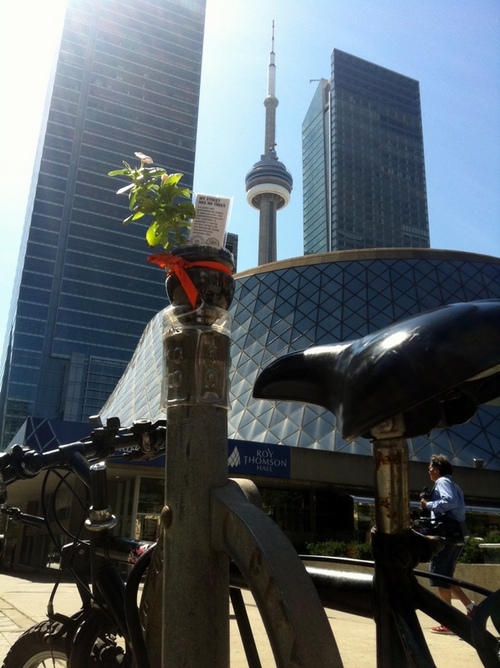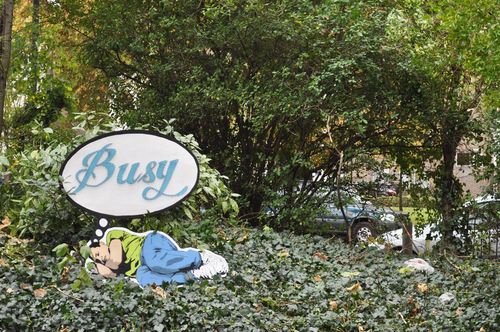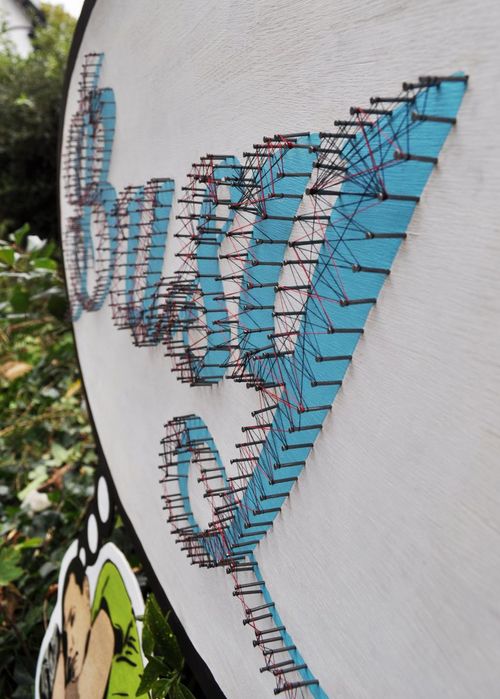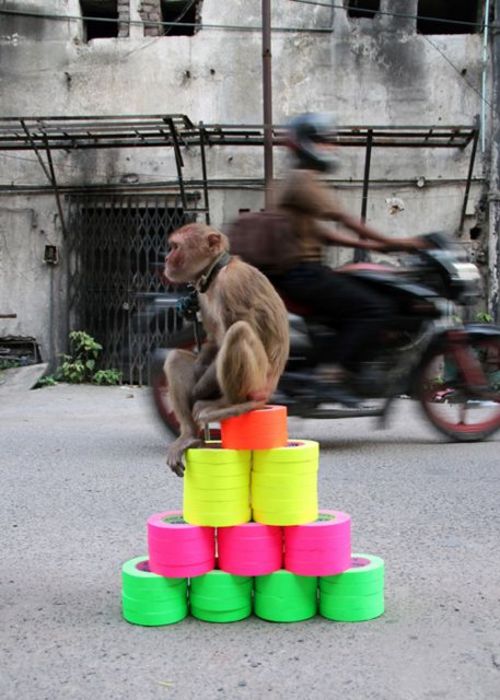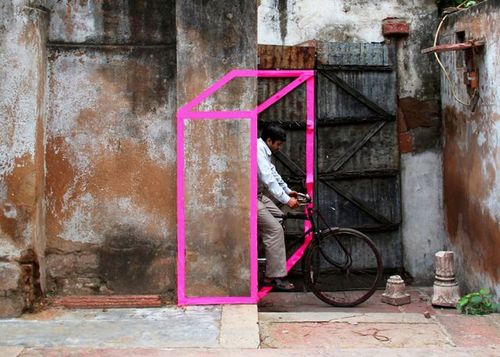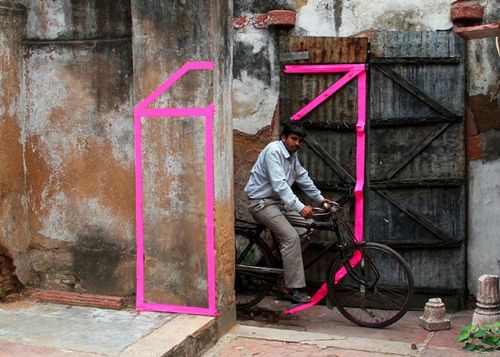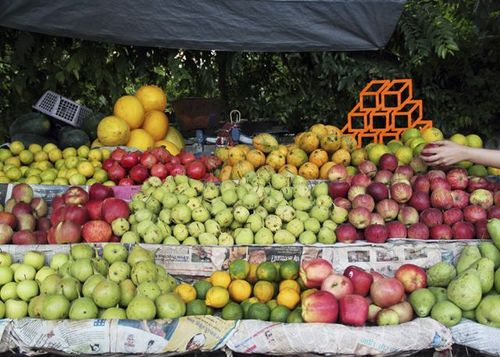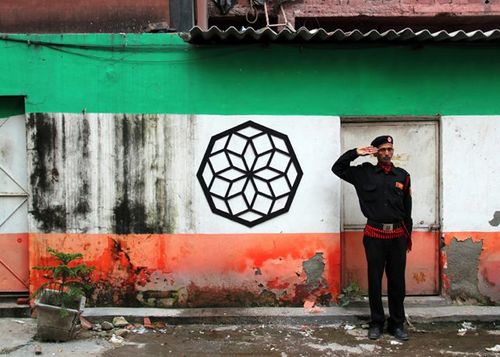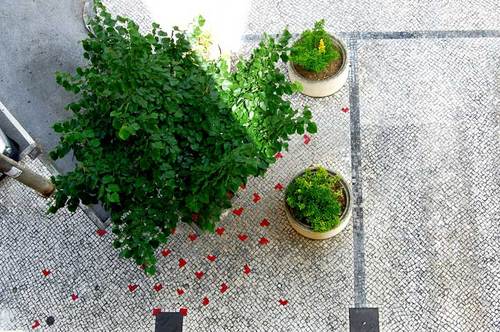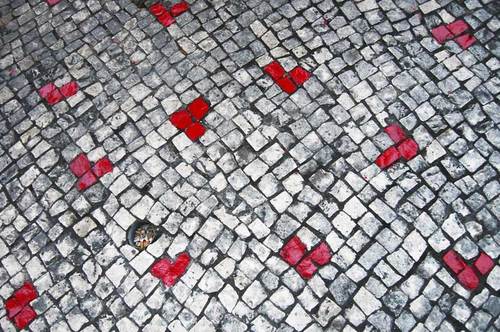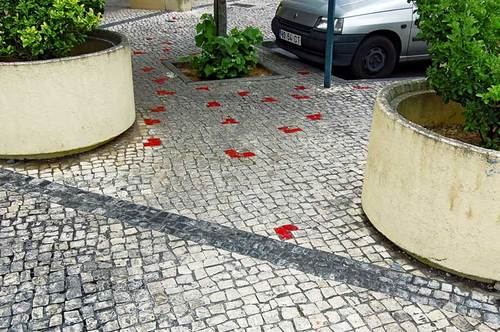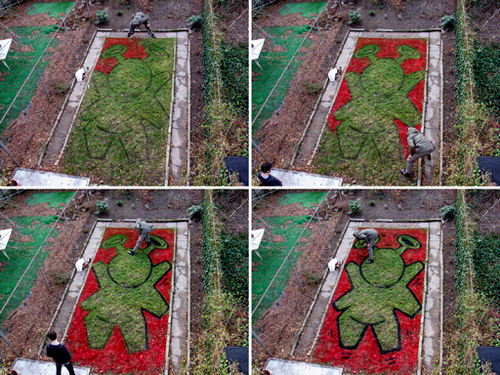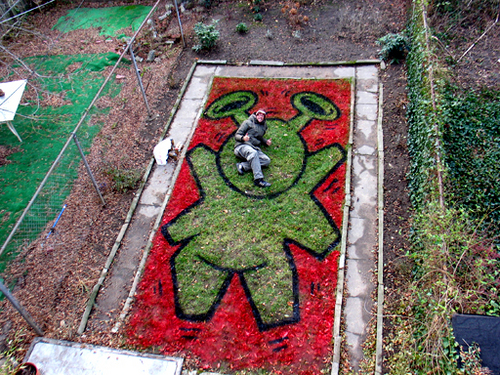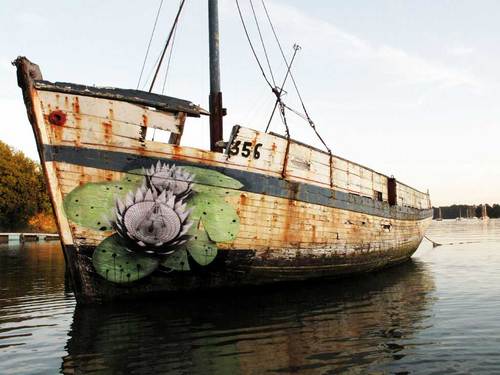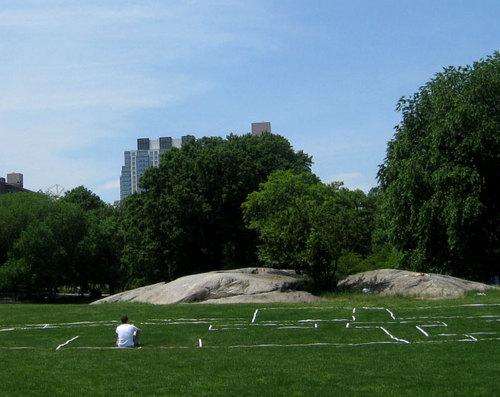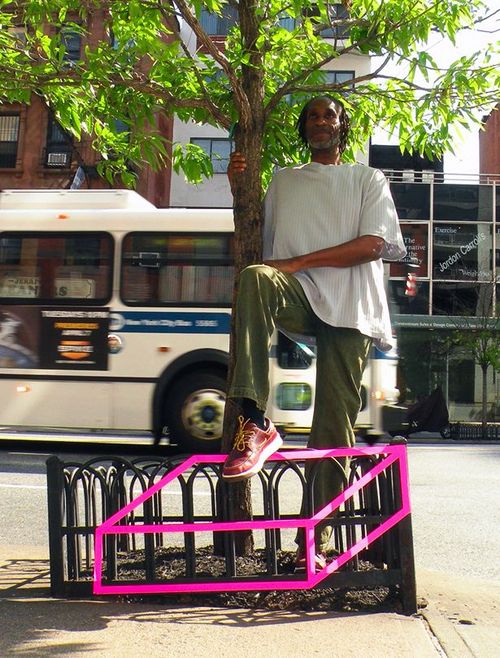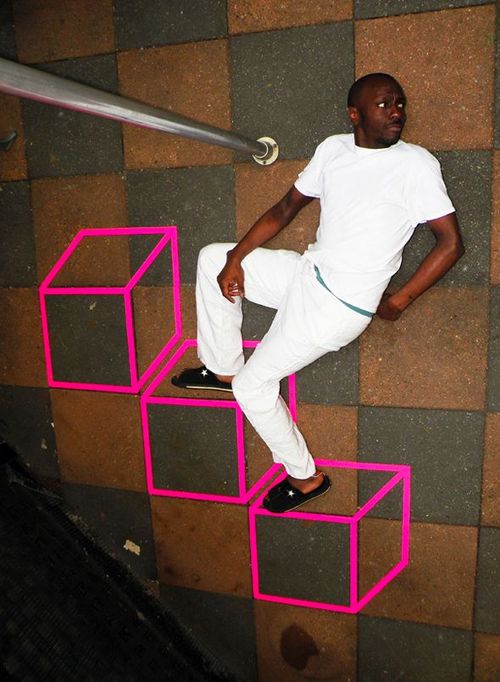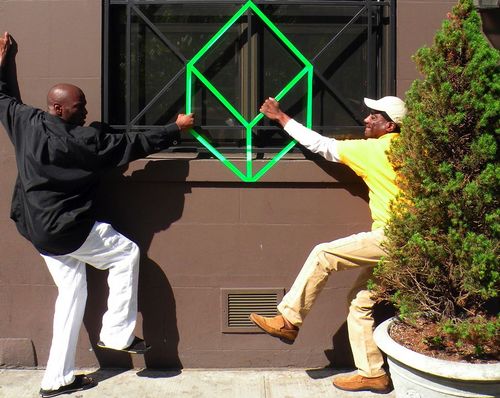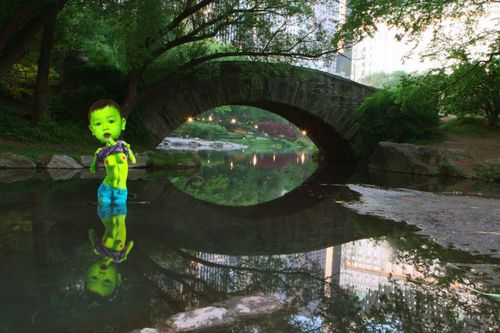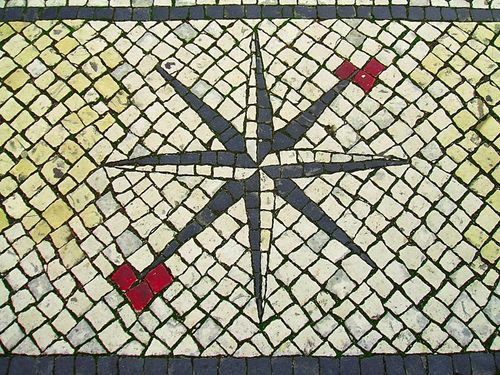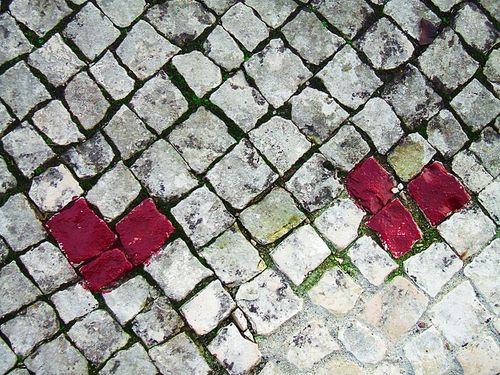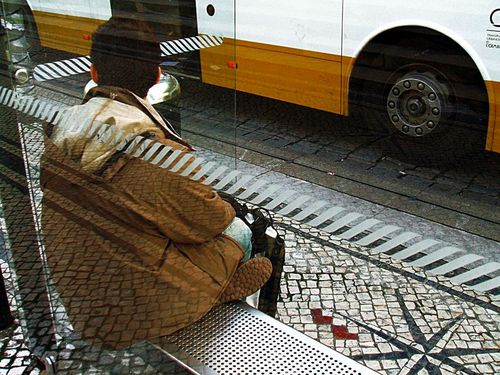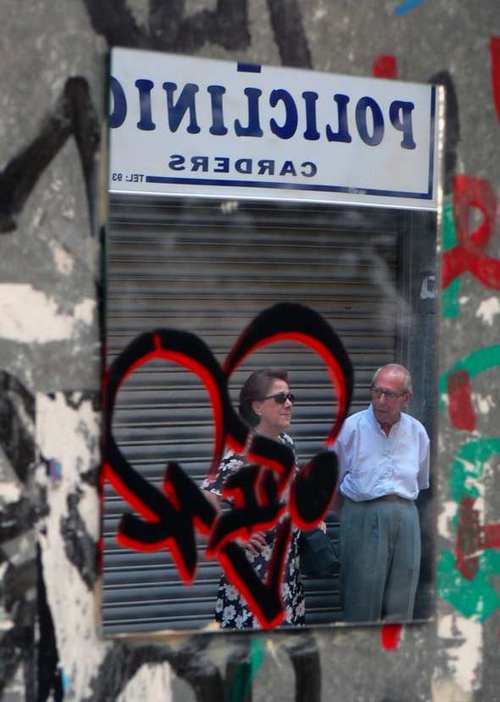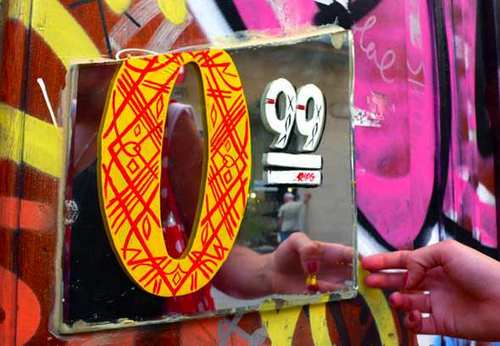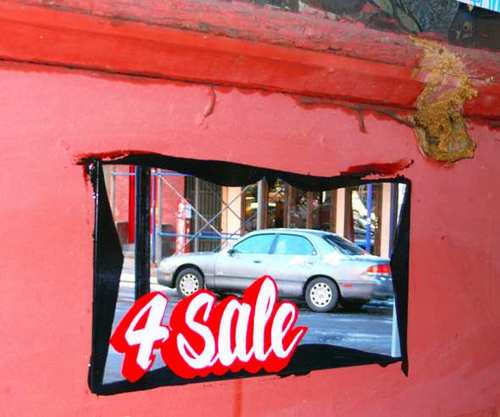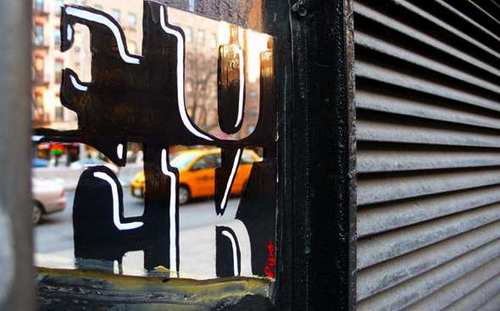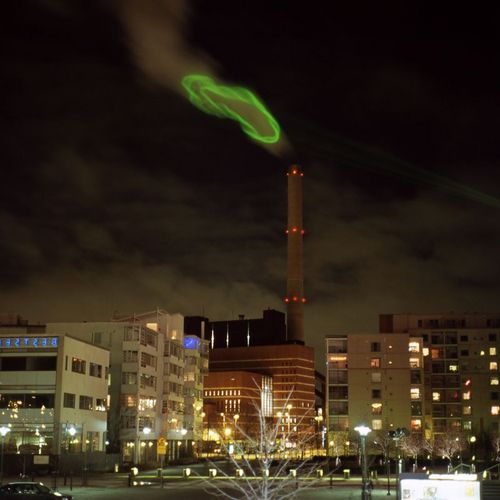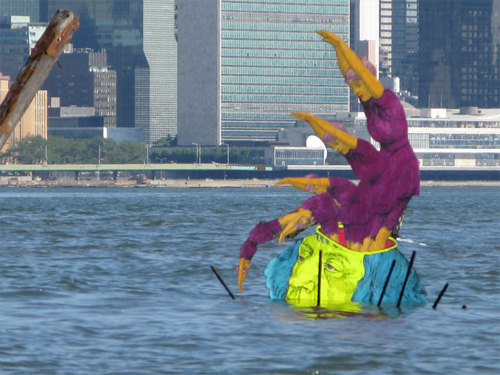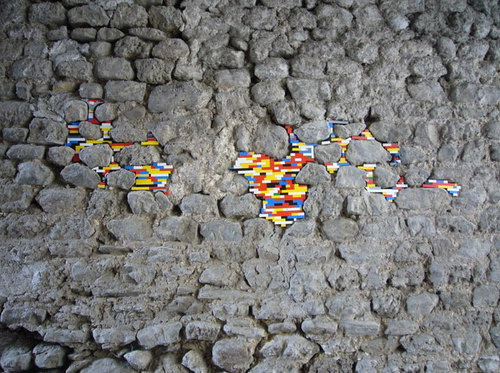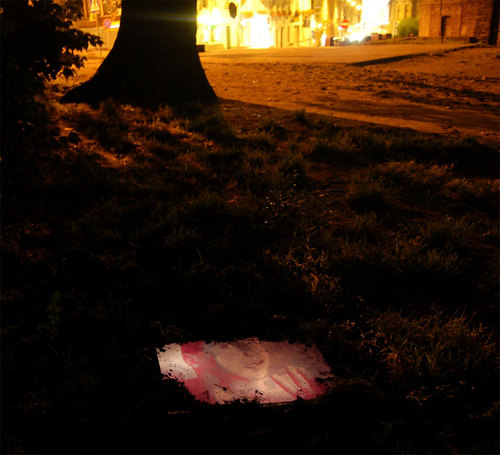November 27, 2011
"My Street Has No Trees (MSHNT) is a public and participatory installation that utilizes the vestigial design of Toronto’s Post and Ring bike stands as armatures for micro-gardens. The intent of the project is to raise awareness about the imbalance between the hardscapes and softscapes of our streets, to encourage people to think critically about the transformative possibilities of our everyday environments, and to increase the beauty and joy of our neighbourhoods."
Posted by marc at 6:30 PM in Environmental |
October 11, 2011
More here.
Posted by marc at 7:09 AM in Environmental |
September 27, 2011
Posted by marc at 7:11 AM in Environmental |
July 7, 2010
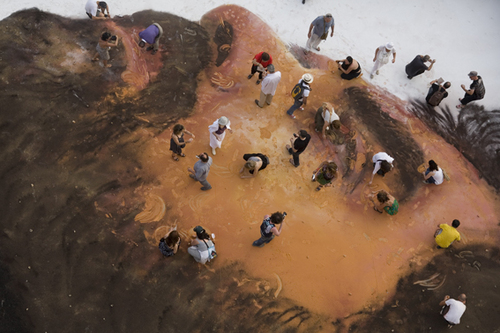
Photo by Ana Alvarez-Errecalde
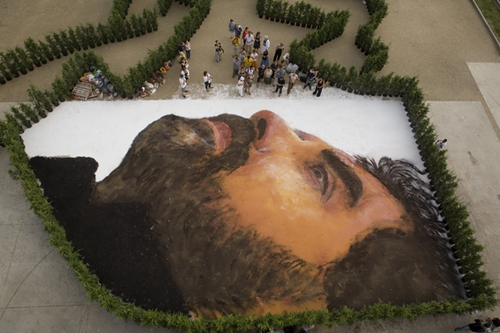
Photo by Ana Alvarez-Errecalde
Jorge Rodriguez-Gerada's latest sand painting was created (transformed and undone) on July 3rd, 2010. The portrait is of Enric Miralles, a Spanish architect who died at the early age 44 leaving an amazing legacy. His wife, architect Benedetta Tagliabue and their studio EMBT, organized the work and a picnic for family and friends to commemorate the 10th anniversary of Enric´s death.
Posted by marc at 7:26 AM in Environmental |
July 1, 2010
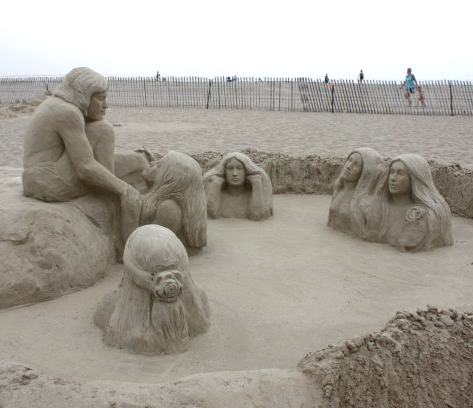
Marielle Heesels
Rijen, Netherlands
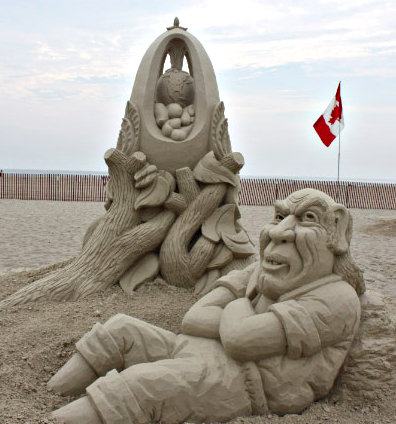
Justin Gordon
Groveland, Massachusetts
"It's No Yolk"
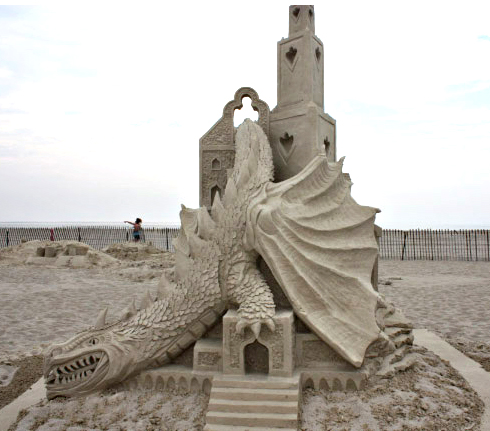
Michel Lepire
Charlesbourg, Quebec
"The Enchanting Spirit"
See the whole series here.
Posted by marc at 7:47 AM in Environmental |
From Juan:
"It’s been 3.5 years now that our long distance overseas relationship exists for Catarina and me. One beautiful spring night, on my recent trip to Coimbra, Portugal, we painted our hearts below the tree’s canopy that is in front of the entrance to her condo, and just below her bedroom balcony for her to see. We call it, “The Love Tree.”
Posted by marc at 6:54 AM in Environmental |
June 30, 2010
From Jeff:
"Inspired by Paris artist, Jerome G. Dermuth, we've taken on 7 (more to follow) swing installation in San Francisco as part of an ongoing Happiness Project aimed at loss of youth. The short video below shows the installation, scouting, and lots of footage of randoms using the swings with complete and utter joy as they relent to a push and some wind in their hair. Watch it through. The joy as this autistic kid's father's face as he gets on a swing for the first time in 40 years is our parting shot. It's pure and simple bliss that's sadly been long ignored and forgotten."
Posted by marc at 6:04 AM in Environmental |
February 17, 2010
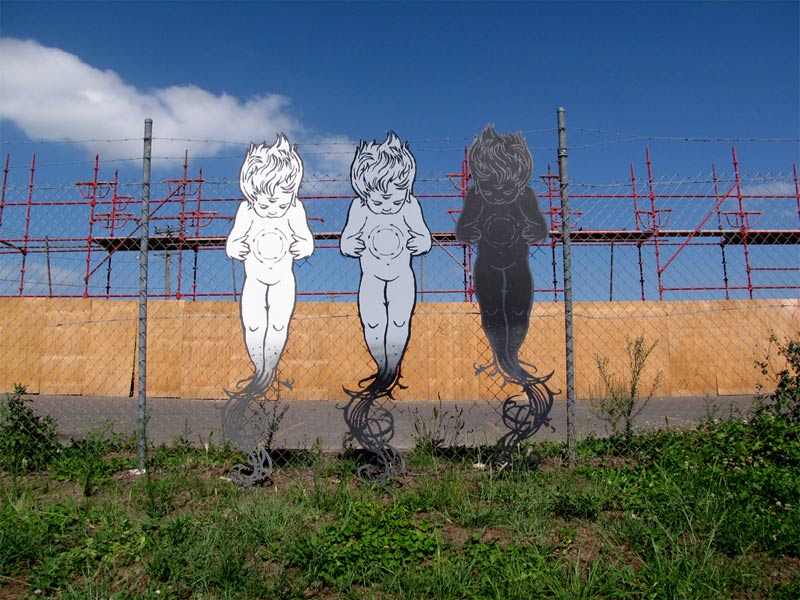
From Wing:
"Rebirth and renewal ongoing themes in my work. My favorite local 70's ice skating rink was demolished and the "Man" is building units. I collected discarded wood panels, half full paint buckets and almost empty spray cans from the demolition site. All of the materials were found at the site. I created half human a half spirit figures in my studio then placed them back at the site. I wanted people to see that you can create something beautiful by recycling and not spending a cent. I hope it will inspire the developers others to recycle and reuse existing materials. I have titled the work"Development". This reflects both the greed of capitalist people and a personal spiritual quest to find a happy medium between the two life styles."
Posted by marc at 7:22 AM in Environmental |
December 25, 2009
For the story, click here.
Posted by marc at 8:55 AM in Environmental |
August 21, 2009
More from Ludo here.
Posted by marc at 10:18 AM in Environmental |
May 27, 2009
From our friend Scott Wayne Indiana:
"Last year I spent a day in my hometown of Keizer, Oregon. Driving through the neighborhoods brought extremely specific memories to the surface. Curiously reflecting on that day, I decided to draw (with masking tape) a floorplan to scale of my childhood home to see what memories would reveal themselves to me. I chose a location in Central Park alongside ballfields where I'd feel comfortable spending time in my space.
To paraphrase Aldous Huxley, everyone's memory is their private literature. And, personally, my experience turned out to be more about the sensory memory that consumed me in the space, and less about interesting details. Which is to say, this experiment creates a highly subjective effect. For example, I had a deep sense of remembering the feeling of looking over at the kitchen as my mom finished preparing dinner. Consequently, I won't go into the minutia of my excavated memories. However, if this sounds intriguing to you, find a fitting public space and give it a try."
Posted by marc at 8:06 AM in Environmental |
May 22, 2009
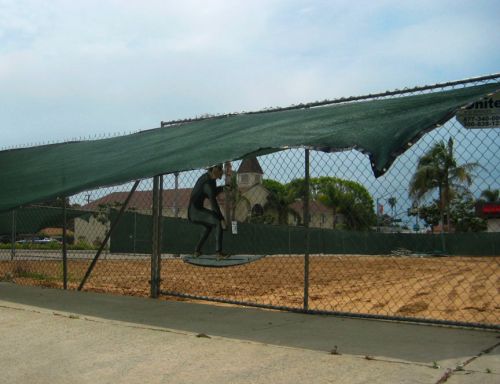
Carlsbad Sidewalk Surfer by bryan snyder from Bryan Snyder on Vimeo.
From Bryan:
Carlsbad Sidewalk Surfer interacts with its environment during mid day wind gusts. Like the waves that tumble upon our shore, the visibility of this art piece depends on the weather. Between the glassy conditions of the morning and the mellow winds at dusk, the Carlsbad Sidewalk Surfer sneaks into another ride. The goal of this project is to showcase the relationship between a piece of art and its environment when placed in the streets."
Posted by marc at 7:54 AM in Environmental |
May 17, 2009
We absolutely loved this street intervention project in which the artists the altered public lighting in Tel Aviv's open underground tunnels.
Artists Bar&Shay said their street art muse was Dorothy from the Wizard of Oz as they altered the tunnel from this....
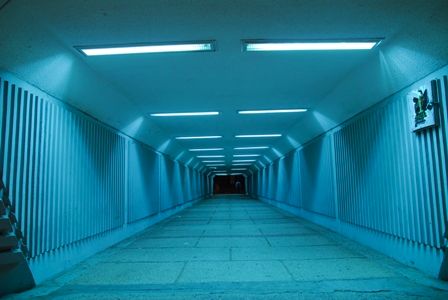
to this....
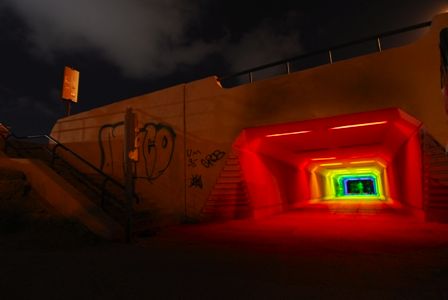
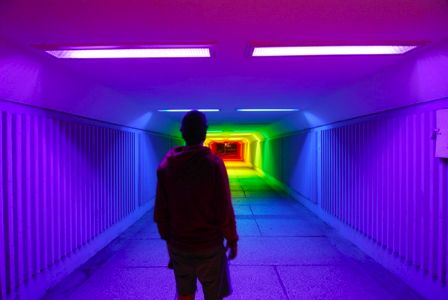
Posted by marc at 11:39 AM in Environmental |
May 15, 2009
We've been a fan of Aakash Nihalani's work for a while now. It was nice to get the following note from him yesterday:
"I saw that post about what people are passionate about, and I wanted to share a project I was very grateful to be involved with. Yesterday, ACNY invited me to do some installations at A Better Place, a permanent housing program in New York City for homeless men and women living with HIV/AIDS. I wasn't sure how willing the residents were to participate, but their cautions, and my timidity, quickly diminished once we started taping. By the end of the afternoon, they were all coming up with great suggestions on how to interact with their environment; each wanting to pose next to the pieces they helped create."
You can see more of Aakash's work here.
Posted by marc at 7:02 AM in Environmental |
May 14, 2009
How fucking awesome is this piece installed by Judith Supine yesterday in Central Park. He told us - "I sank in the mud up to my waist."
Posted by marc at 6:32 AM in Environmental |
May 4, 2009
"These hearts were painted by my girlfriend and I in Coimbra, Portugal a couple of years back. She is from Coimbra and I am from Chicago and we've been able to maintain a long distance relationship for the past 2.5 years. Since then, we continue to paint some of these hearts every time we are together in Coimbra. What is interesting about Portugal's Calçada (sidewalk), is that you can take a combination of a minimum of three stones and find the shape of an abstract heart form. The heart can grow by adding more stones to the original three."
Posted by marc at 7:16 AM in Environmental |
April 30, 2009
Artist Statement (nicked from Kacie's terrific site)
"In New York, we are very occupied with getting from one place to another. I wondered: could a human-like object traverse sidewalks and streets along with us, and in so doing, create a narrative about our relationship to space and our willingness to interact with what we find in it? More importantly, how could our actions be seen within a larger context of human connection that emerges from the complexity of the city itself? To answer these questions, I built robots.
Tweenbots are human-dependent robots that navigate the city with the help of pedestrians they encounter. Rolling at a constant speed, in a straight line, Tweenbots have a destination displayed on a flag, and rely on people they meet to read this flag and to aim them in the right direction to reach their goal.
Given their extreme vulnerability, the vastness of city space, the dangers posed by traffic, suspicion of terrorism, and the possibility that no one would be interested in helping a lost little robot, I initially conceived the Tweenbots as disposable creatures which were more likely to struggle and die in the city than to reach their destination. Because I built them with minimal technology, I had no way of tracking the Tweenbot’s progress, and so I set out on the first test with a video camera hidden in my purse. I placed the Tweenbot down on the sidewalk, and walked far enough away that I would not be observed as the Tweenbot––a smiling 10-inch tall cardboard missionary––bumped along towards his inevitable fate.
The results were unexpected. Over the course of the following months, throughout numerous missions, the Tweenbots were successful in rolling from their start point to their far-away destination assisted only by strangers. Every time the robot got caught under a park bench, ground futilely against a curb, or became trapped in a pothole, some passerby would always rescue it and send it toward its goal. Never once was a Tweenbot lost or damaged. Often, people would ignore the instructions to aim the Tweenbot in the “right” direction, if that direction meant sending the robot into a perilous situation. One man turned the robot back in the direction from which it had just come, saying out loud to the Tweenbot, "You can’t go that way, it’s toward the road.”
The Tweenbot’s unexpected presence in the city created an unfolding narrative that spoke not simply to the vastness of city space and to the journey of a human-assisted robot, but also to the power of a simple technological object to create a complex network powered by human intelligence and asynchronous interactions. But of more interest to me was the fact that this ad-hoc crowdsourcing was driven primarily by human empathy for an anthropomorphized object. The journey the Tweenbots take each time they are released in the city becomes a story of people's willingness to engage with a creature that mirrors human characteristics of vulnerability, of being lost, and of having intention without the means of achieving its goal alone. As each encounter with a helpful pedestrian takes the robot one step closer to attaining its destination, the significance of our random discoveries and individual actions accumulates into a story about a vast space made small by an even smaller robot."
Posted by marc at 8:10 AM in Environmental |
March 3, 2009
"Mirrors are more than just something to see yourself in.
As a child I always thought they were actually windows into another world, one that was so familiar yet completely opposite.
The Reflect On project speaks via these windows. They are visual messages to us from our other selves and a reflection of the world we inhabit.
The photos of these paintings are simply snapshots of paintings that are constantly moving and changing.
When you look into a mirror you are the only subject that it speaks to and about in that moment. When you move on it is no longer yours.
In the public space these mirrors are everyone's and they are about everyone.
This project has been ongoing since 2006 and the mirrors have shown their faces (and yours) in Bucharest, Istanbul, Barcelona, NYC, and Mexico City."
... Ripo
Posted by marc at 7:23 AM in Environmental |
February 13, 2009
Our friends over at PSFK hipped us to HeHe (Helen Evans and Heiki Hansen)'s terrific installation from last year called Nuage Vert, or “Green Cloud” which raises awareness about energy consumption and polution.
PSFK writes:
"Every night for a week, the vapor emissions from the Salmisaari coal burning power plant were illuminated with a high power green laser animation. The laser drew an outline of the moving cloud onto the cloud itself, coloring it green."
The project won the 2008 Ars Electronica Golden Nica.
Posted by marc at 10:20 AM in Environmental |
“The most daring piece of public art ever commissioned in the UK, Turning the Place Over is artist Richard Wilson’s most radical intervention into architecture to date, turning a building in Liverpool’s city centre literally inside out. One of Wilson’s very rare temporary works, Turning the Place Over colonises Cross Keys House, Moorfields. It is on a light sensor and will run during daylight hours.
Co-commissioned by the Liverpool Culture Company and Liverpool Biennial, co-funded by the Northwest Regional Development Agency and The Northern Way, and facilitated by Liverpool Vision, the project is a stunning trailblazer for Liverpool’s Year as European Capital of Culture 2008, and the jewel in the crown of the Culture Company’s public art programme.”
Posted by marc at 8:07 AM in Environmental |
December 13, 2008
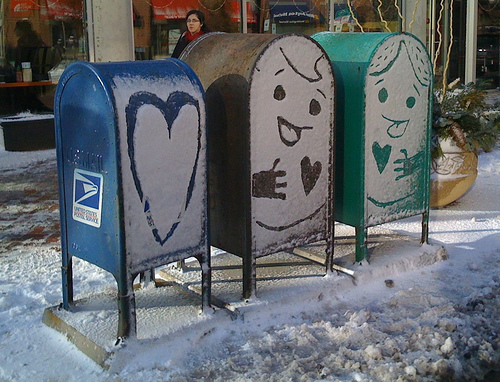
Photo nicked from here..
Posted by marc at 6:48 AM in Environmental |
December 2, 2008
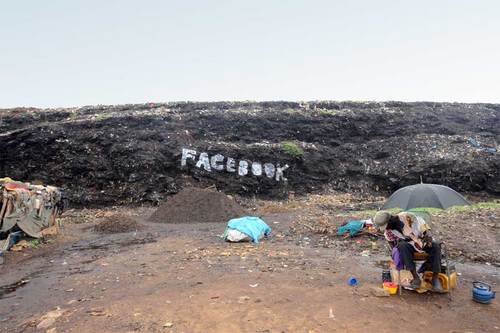
("Facebook", spray paint on scrap-yard, Bamako - Mali, 2008 )
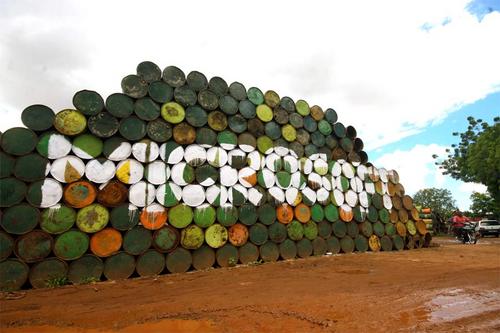
("Microsoft", Paint on barrels, Bamako-Mali. 2008)
("Flickr", Paint on wall, Phnom Penh-Cambodia. 2007)
("Myspace", Paint on wall, Phnom Penh-Cambodia. 2007)
The more we see of Filippo Minelli's work, the more we've love it. We were really struck by his ongoing series "Contradictions" so we asked Filippo to tell us a bit about the images. We thought we'd share with you his response:
"All my "Contradictions" ongoing project has the same motivation/meaning. Technologies and the marketing behind them usually push the almost religious aspect of their evolution, as also said by Leander Kaheny in his "Cult of Mac" book, and the users are pushed to live in an intense way the abstraction from reality, living technologies only as an idea and sometimes without even knowing their real functions. And this aspect works for the social-networks too. The idealization connected with these experiences provokes a small-but-important detach of the perception of reality and what i want to do by writing the names of anything connected with the 2.0 life we are living in the slums of the third world is to point out the gap between the reality we still live in and the ephemeral world of technologies. It's a kind of reminder, for people like me which i'm an Apple user and also have social-network accounts that the real world is deeply far from the idealization we have of it, not only in the third world and even if technologies and globalization are good things. I hope it's clear and sorry for my italian-english" ;)"
You can see more of Filippo's work here.
Posted by marc at 5:04 AM in Environmental |
October 8, 2008
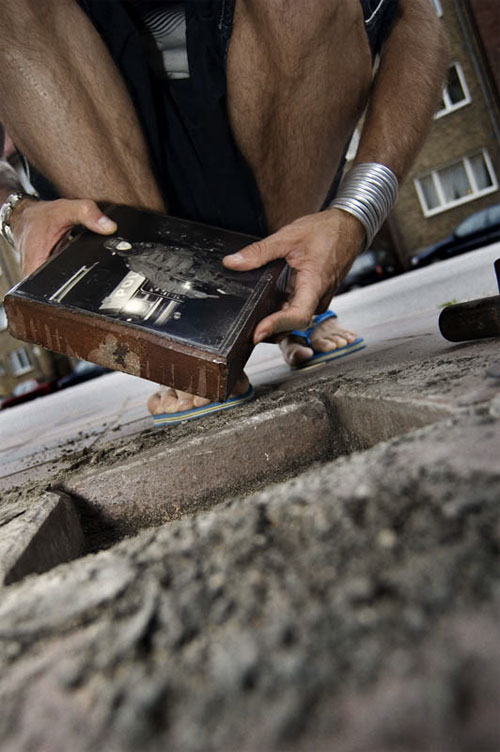
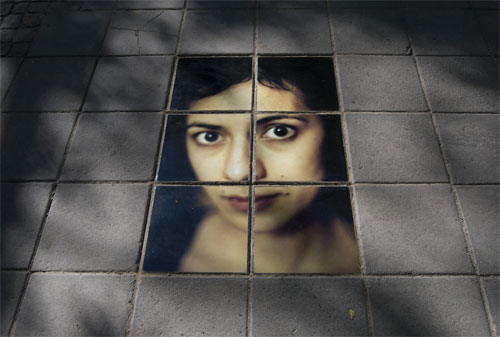
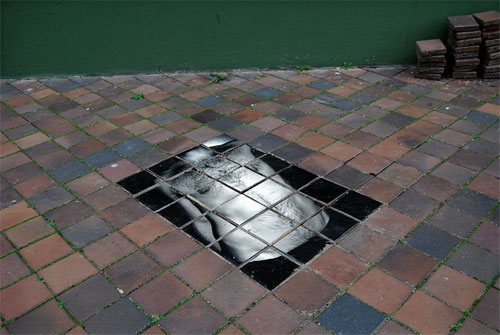
For us, the most inspiring street art, is when then motivation of the artist is to beautify ugly spaces. That's why we love the Malmoe Streets Project so much.
In the city of Malmoe, Sweden, a group of artists have been replacing the drab boring street tiles that cover the city, with much more inspiring images.
Posted by marc at 7:18 AM in Environmental |
September 8, 2008
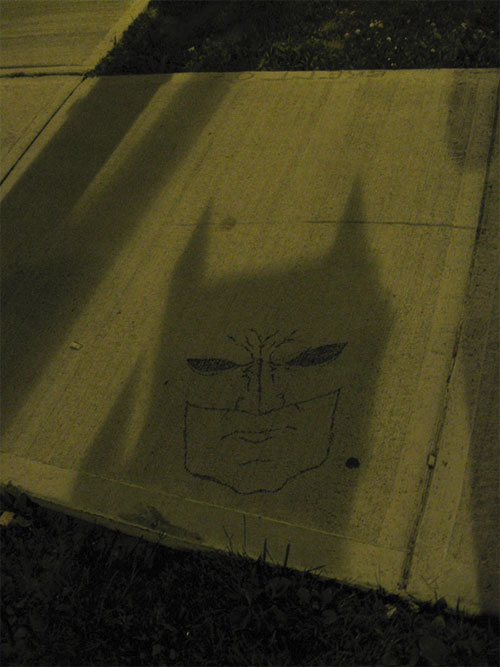
From Rosemary:
"The night is mine.
I saw this walking home from the train station after I was at the Speakeasy Illustration show in Toronto. The crosswalk box thing made this shadow on the ground and someone drew a most perfect Batman face on it! I laughed so hard when I saw it. So unexpected and awesome!
Spotted near the corner of Iroquois Shore on Trafalgar road in Oakville Ontario. "
Posted by marc at 7:41 AM in Environmental |
August 18, 2008
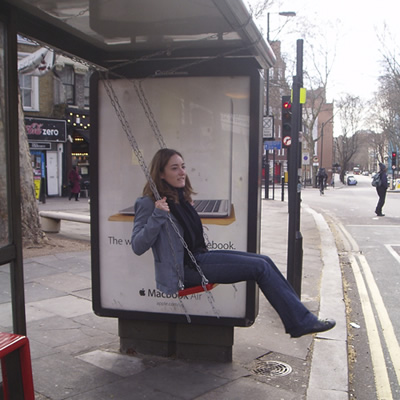
“71% of adults used to play on the streets when they were young. 21% of children do so now. Are we designing children and play out of the public realm?
This project is a study into different ways of bringing play back into public space. It focuses on ways of incorporating incidental play in the public realm by not so much as having separate play equipment that dictates the users but by using existing furniture and architectural elements that indicate playful behaviour for all.
It asks us to question the current framework for public space and whether it is sufficient while also giving permission for young people to play in public.
Play as you go…” Bruno Taylor."
(via)
(Thanks, Joel)
Posted by marc at 8:03 AM in Environmental |
July 24, 2008
Posted by marc at 8:09 AM in Environmental |
June 6, 2008
You can see more of Jan Vormann's project here. They are quite beautiful.
Posted by marc at 6:48 AM in Environmental |
June 4, 2008
Posted by marc at 8:09 AM in Environmental |
May 30, 2008
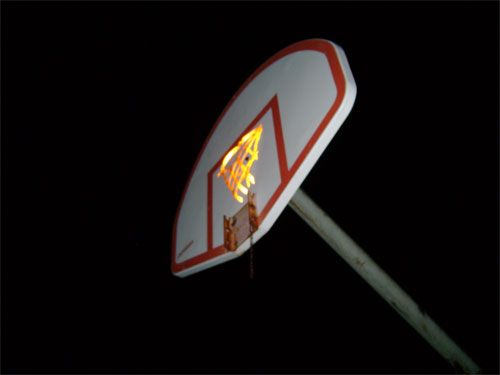
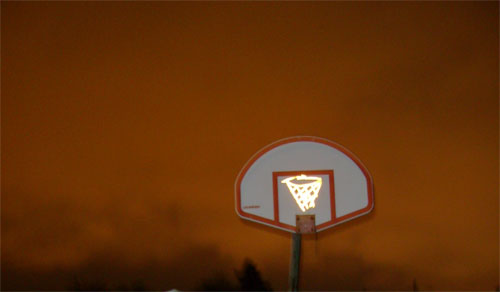
From Relic: "some milwaukee wisconsin midwest shit. after hoops are taken down in a local playground."
Posted by marc at 7:15 AM in Environmental |
May 13, 2008
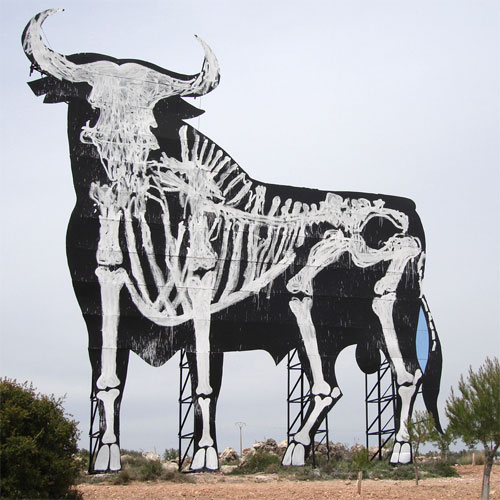
More from Sam3 here.
Posted by marc at 7:13 AM in Environmental |
January 7, 2008
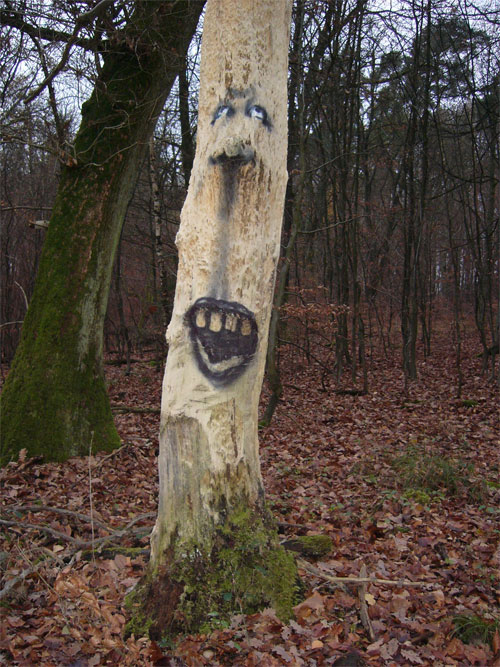
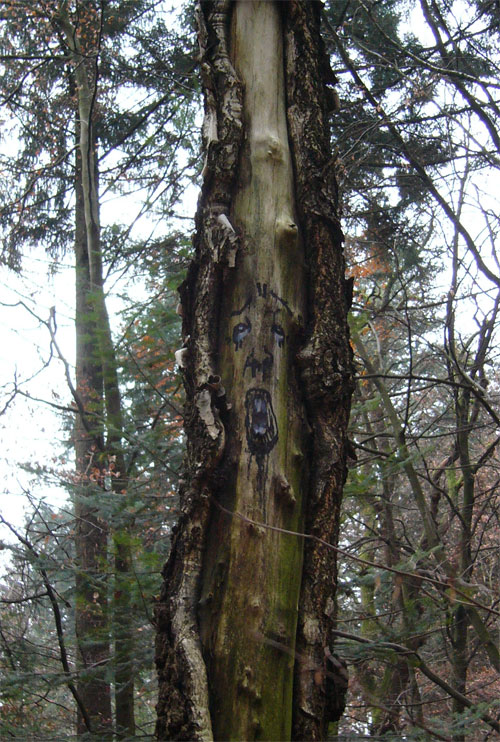
Posted by marc at 7:54 AM in Environmental |
November 22, 2007
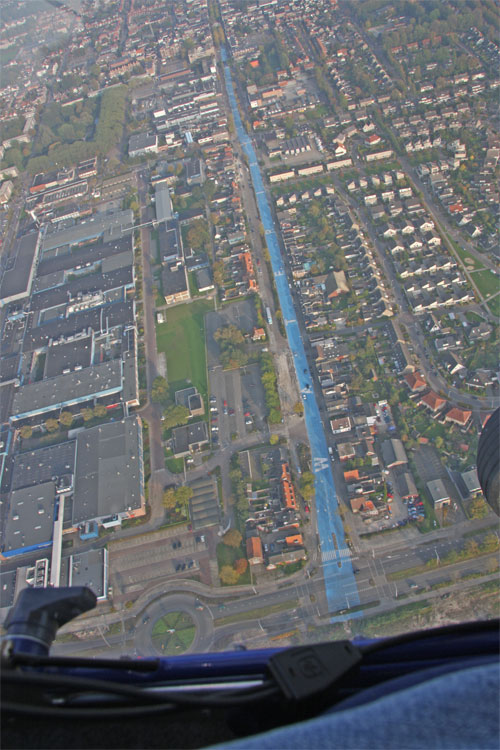
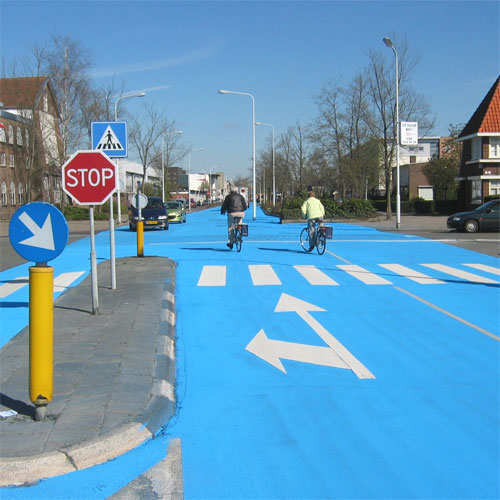
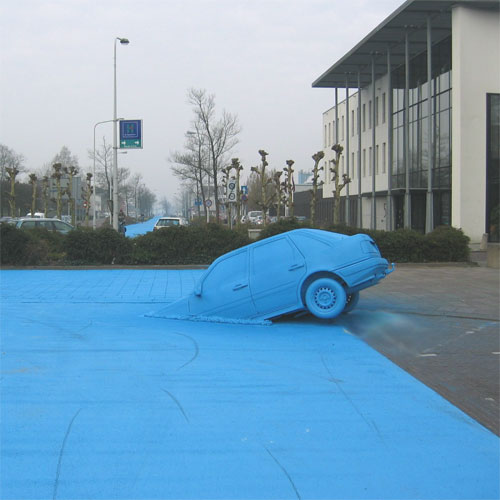
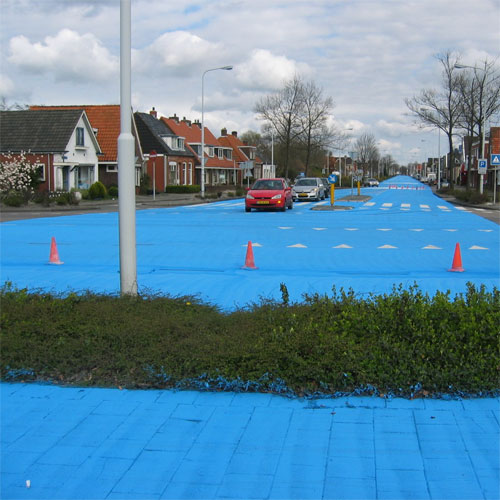
Henk Hofstra's blue road in Drachten (Holland) stretches 1000 meters long.
Posted by marc at 7:48 AM in Environmental |
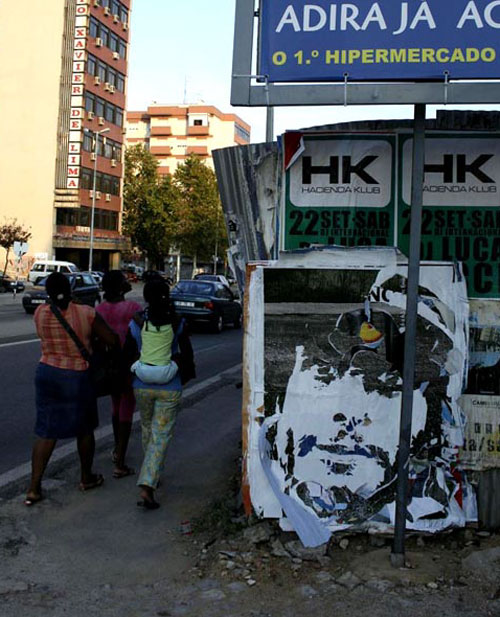
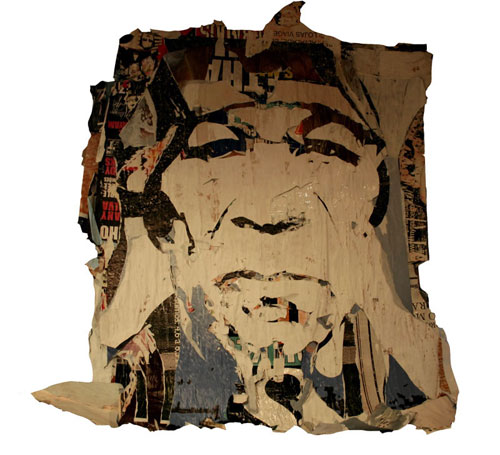
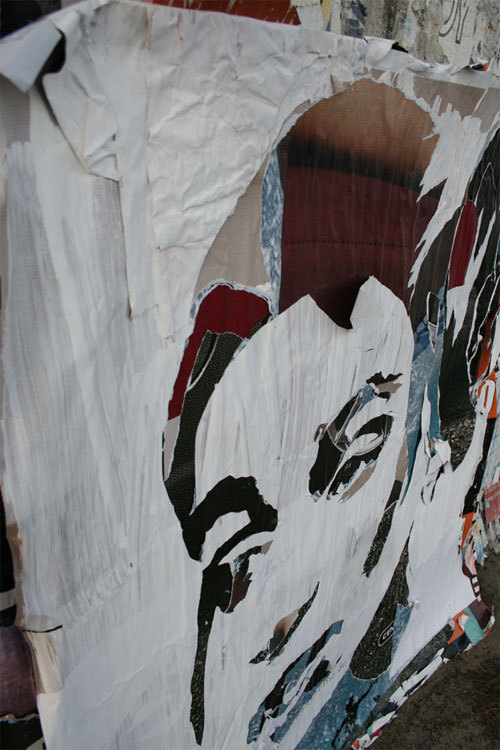
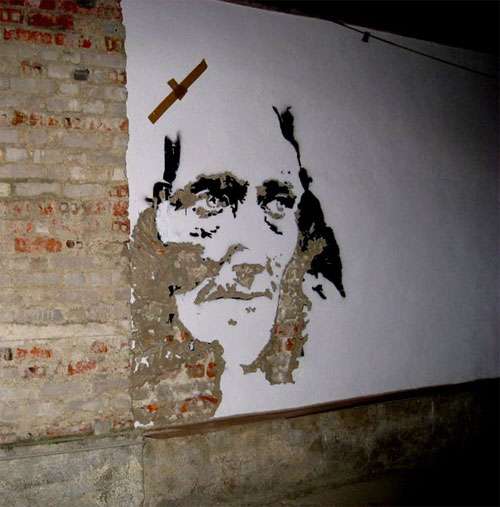
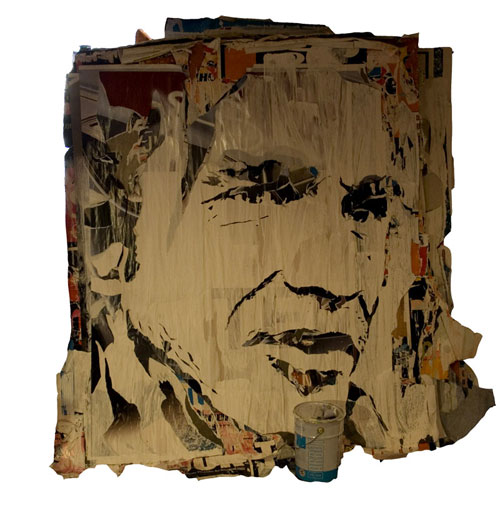
You can see more of Alexandre's work here.
Posted by marc at 7:37 AM in Environmental |
October 25, 2007
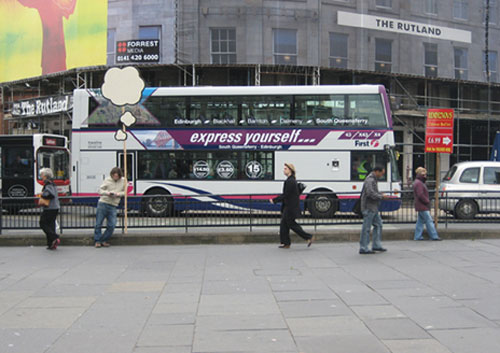
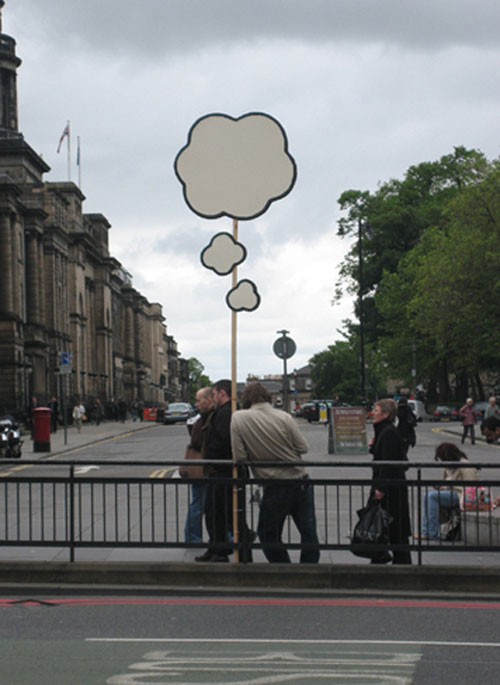
Location: Princess Street In Edinburgh, Scotland.
Posted by marc at 7:20 AM in Environmental |
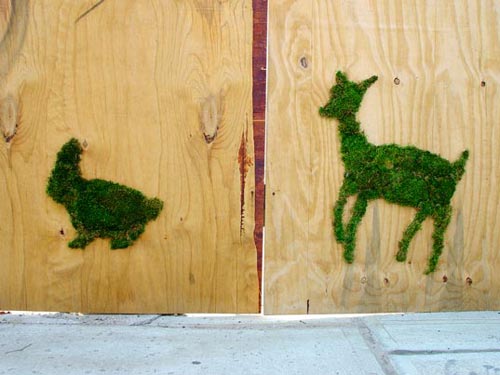
You can learn more about Edina's work on Inhabitat.
Posted by marc at 7:15 AM in Environmental |
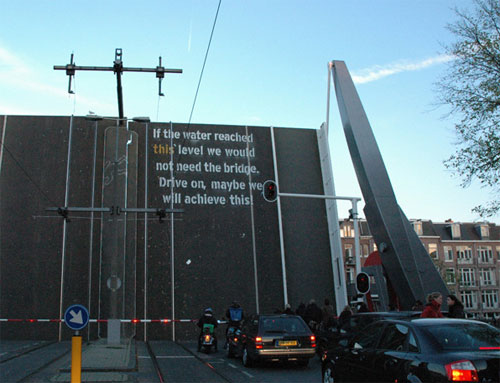
Posted by marc at 7:12 AM in Environmental |
October 22, 2007
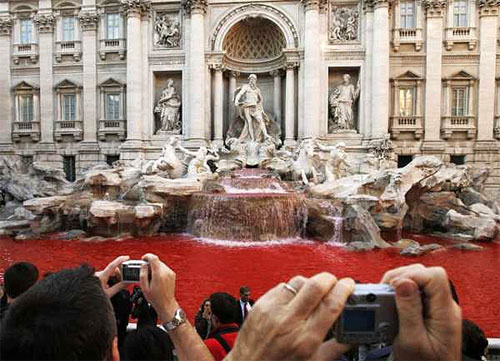
From EternallyCool.net:
'On October 19th, the waters of Rome’s famous Trevi Fountain turned blood red when a man threw paint into the basin in a bizarre act of vandalism apparently inspired by the Futurists of the early 20th century.
The man, reportedly wearing a beret and a light-colored jacket, struck at around 4.30 pm and then disappeared into the crowd of tourists, leaving behind a pile of leaflets. The fountain, which re-uses the same water in a continuous cycle, soon started spurting red water into the air from its jets, providing an unprecedented spectacle which tourists immediately began photographing. Police arrived and technicians briefly shut off the water before restoring a clear flow.
Experts said the baroque fountain was not permanently damaged and the marble statues depicting the sea deity Neptune on his chariot had not absorbed the color.
“There shouldn’t be any relevant damage,” said Eugenio La Rocca, superintendent for Rome’s monuments.
The news agency ANSA reported that a box was found near the fountain containing leaflets by a group that claimed responsibility for the act. The leaflets found beside the fountain claimed that the coloring of the monument had been carried out by ‘FTM Futurist Action 2007,’ a group which has not been heard of before.
The leaflets state that the group aims to battle against “everything and everyone with a spirit of healthy violence” and to turn this “grey bourgeois society into a triumph of color.” As well, the leaflets proclaim that the red paint was a protest for expenses incurred in organizing the Rome Film Festival and symbolically referred to the event’s red carpet."
Posted by marc at 8:24 AM in Environmental |
October 14, 2007
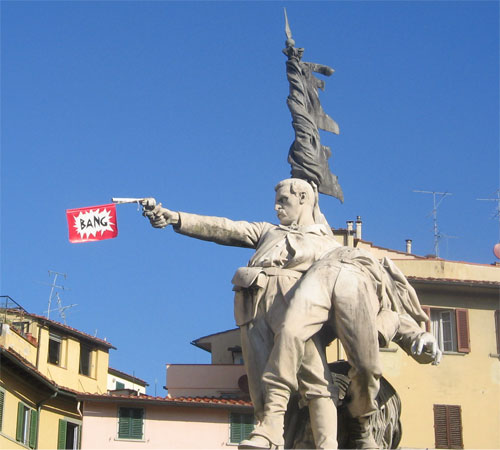
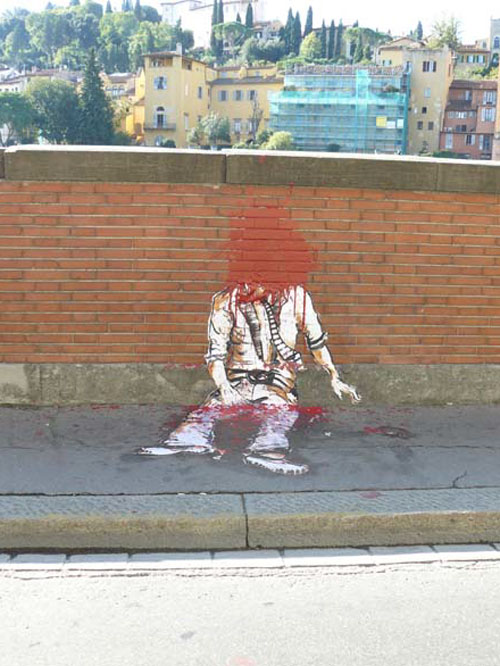
(To explain, the gun in the statue is pointing at the wall where the dead man is)
Posted by marc at 9:27 PM in Environmental |
October 11, 2007
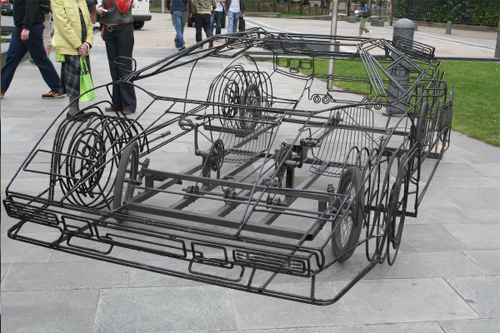
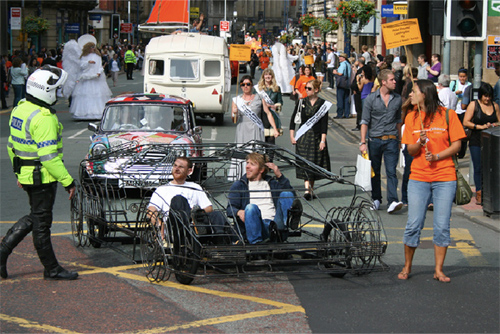
"The work questions the combustion engine, celebrates bicycle efficiency and the striking design of the Lamborghini arguably one of the most iconic super cars of all time, as well as Wilson and Radcliffes commitment to clever and thoughtful craftsmanship. Wilson + Radcliffe are deeply passionate about cars and bikes and have seen each other¹s work at various exhibitions over the last few years. Artcars gave them the opportunity to collaborate on this project. Walk the plank commissioned the piece of work for the uk¹s first ART CAR parade that was held in Manchester last recently."
Posted by marc at 7:56 AM in Environmental |
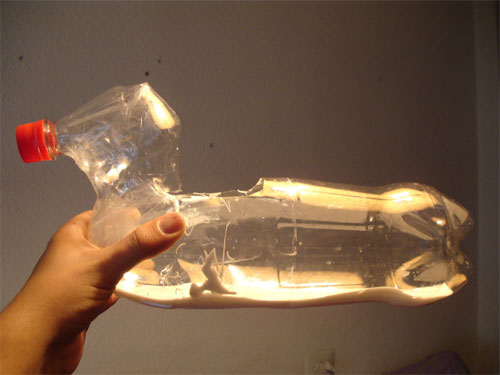
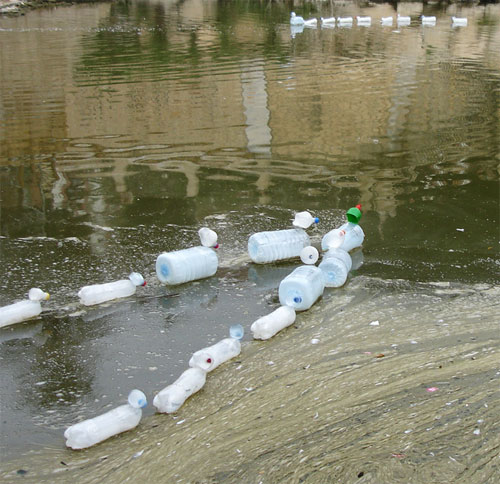
"Many cities repopulate their urban rivers with ducks and swans to somehow clean their visible sewage waters. This installation hopes to clean the reality of the ducks which inhabit these sewage waters by adapting rubbish into their forms
During a whole week plastic bottles will be floated over River Segura. The bottles will be bird shaped, aquatic species, and will form groups and families. All materials used in this installation will be recycled materials and will try not to disturb the inhabitants as much as possible.
If the animal cannot adapt to its environment, the environment must adapt to the animal."
... Sam3
Posted by marc at 7:34 AM in Environmental |
October 9, 2007
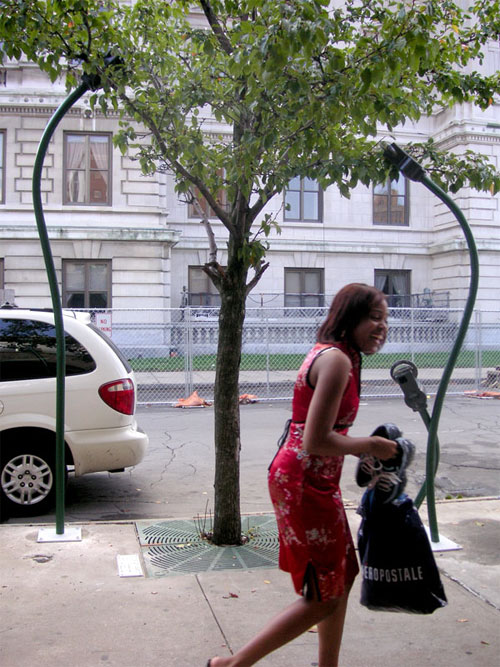
Posted by marc at 7:30 AM in Environmental |
September 13, 2007
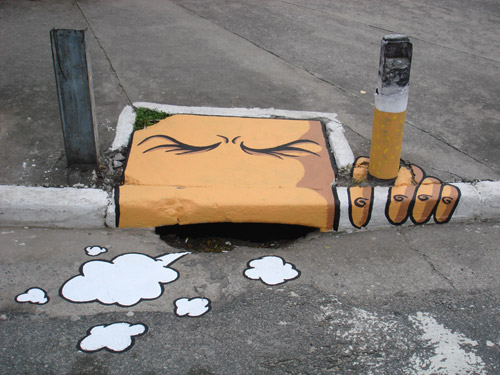
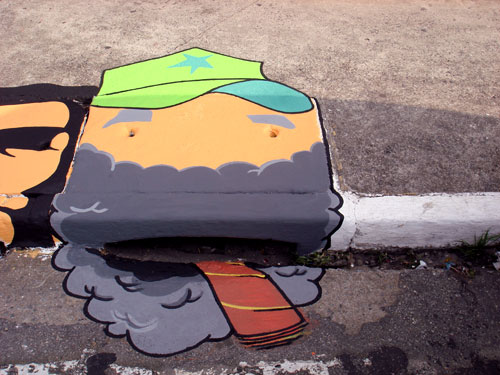
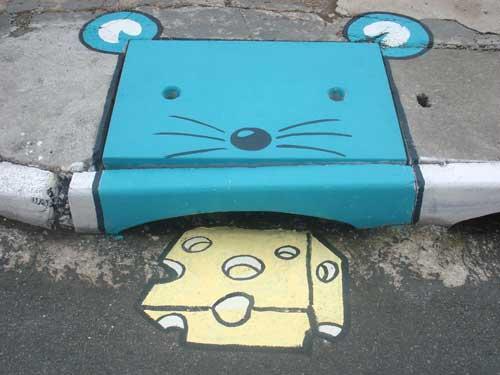
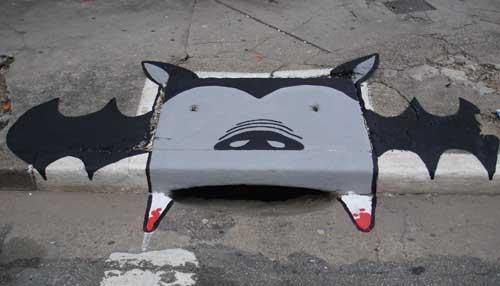
"we are 6emeia, a project created by SAO! and Delafuent, and we are from Sao Paulo city, Brasil and since July 06 we are making that kind of painting in the streets of Sao Paulo"
Posted by marc at 11:28 AM in Environmental |
August 6, 2007
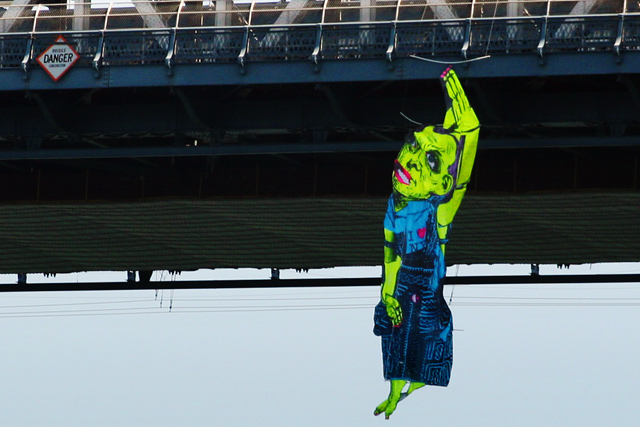
More at Gothamist.
Posted by marc at 11:29 AM in Environmental |
July 30, 2007

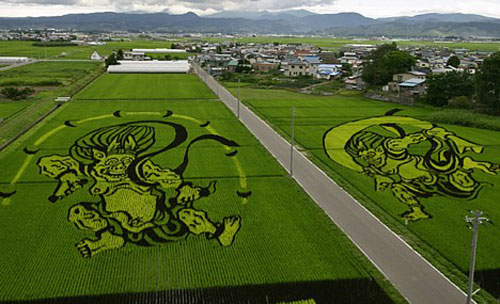
Each year since 1993 the farmers of the Japanese town of Inakadate have been creating massive images with rice by growing a purple and yellow-leafed kodaimai rice alongside the local green-leafed tsugaru-roman rice.
More images here.
(via)
(Thanks Suzanne!)
Posted by marc at 8:35 AM in Environmental |
July 4, 2007
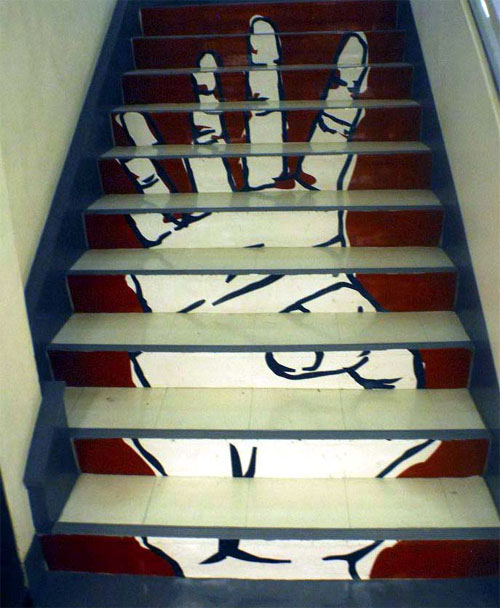

From Future Perfect, a series of photos from Bangkok showing the use of fingers to communicate which floor you are walking up to.
Posted by marc at 9:23 AM in Environmental |
June 8, 2007

(via)
"...This amazing art installation was made by Colombian sculptor Doris Salcedo for the International Instanbul Biennale in 2003. She used over 1,550 chairs stacked on an empty lot between two buildings!"
"Doris Salcedo makes sculptures and installations that function as political and mental archaeology, using domestic materials charged with significance and suffused with meanings accumulated over years of use in everyday life. Salcedo often takes specific historical events as her point of departure, conveying burdens and conflicts with precise and economical means." --White Cube
Posted by marc at 7:20 AM in Environmental |

(via)
Thanks, Kathreen!
Posted by marc at 7:15 AM in Environmental |
May 3, 2007
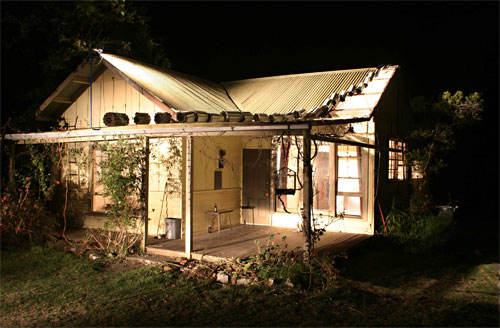
"In February 2007, a group of artists, eight in all, traveled to a house located at 26 Surf Street at Merrick’s Beach in Victoria Australia, with a rare opportunity to do whatever they wished with the house, but with only a few days to work before demolition began. The group had met a few times, and had loosely discussed possible ideas, but there was no common project that necessarily united them. Some members knew the owners of the house, others came to the house as strangers, armed with tools and industrial equipment.."
You can see the documentation of the project here.
Posted by marc at 6:56 AM in Environmental |
April 30, 2007
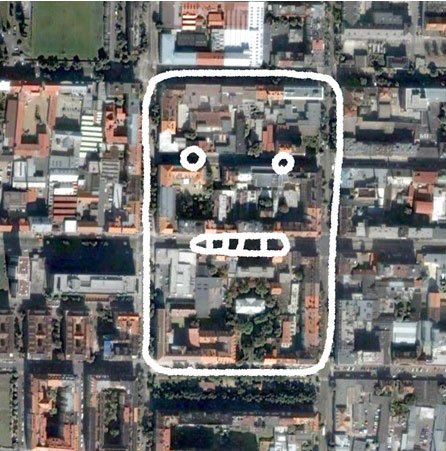
See the project here.
(Thanks, Momo)
Posted by marc at 6:56 AM in Environmental |
April 16, 2007
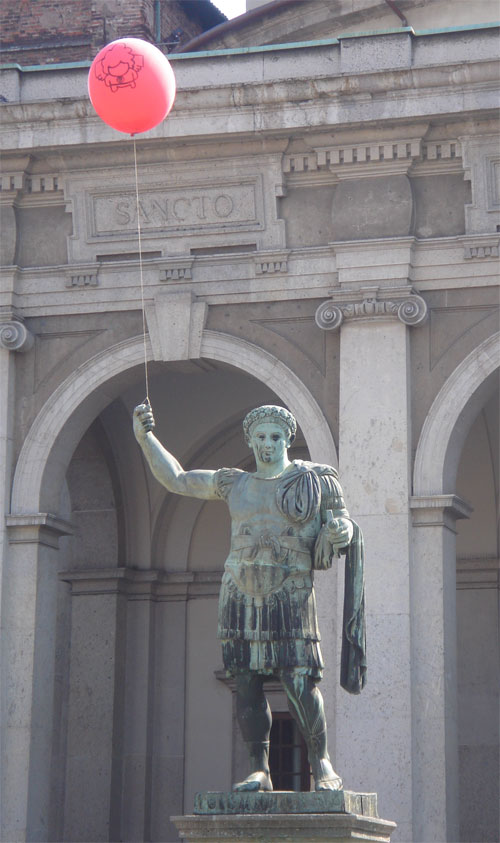
"The concept of this "installation" in Milan was PLAY DONT MAKE WAR. So the statue of the Roman Emperor Costantino is holding a big ballon that means playing and having fun"... BNNI.
Posted by marc at 6:59 AM in Environmental |
April 13, 2007
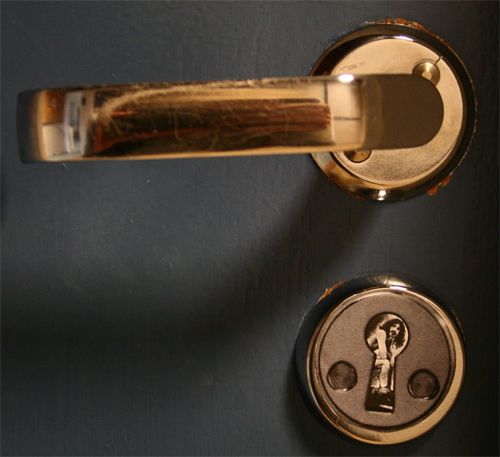
Frank Zappa

Knudzich's tiny Toilet Fantasies installations have appeared on doors at the Norwegian School of Economics and around Bergen, Noway. You can see the series here.
Posted by marc at 8:08 AM in Environmental |
April 6, 2007
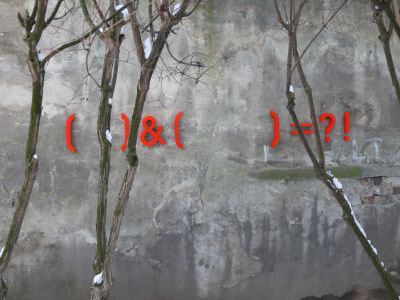
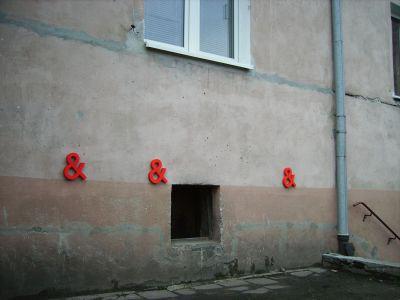
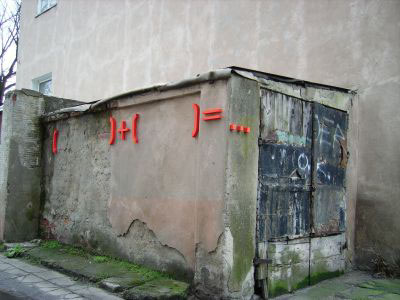
More on the project here and here.
Posted by marc at 7:12 AM in Environmental |
March 8, 2007
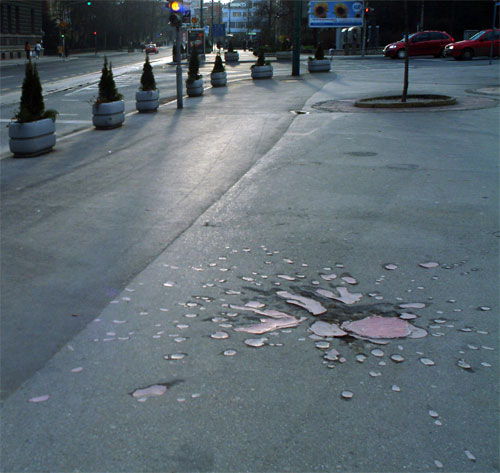
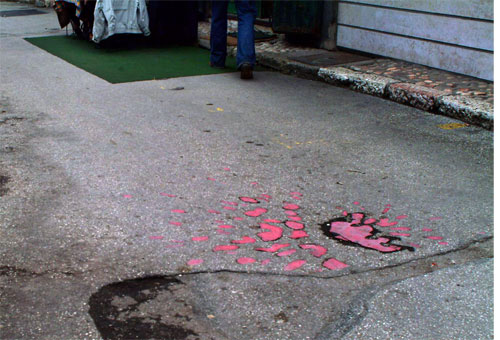
"As I was passing through Sarajevo I couldn't help but notice the effects of the Bosnian War. It's everywhere, in the buildings, in the people, in the graveyards that stretch blocks and blocks. But the most impactful of these markings are on the street. While walking the city you are sure to come across a splattering pattern of pock-marks from where a mortar round hit.
To signify places of significant deaths, the explosion marks are filled in with red resin to create the Sarajevo Rose."
... erik
Posted by marc at 6:52 AM in Environmental |
March 1, 2007
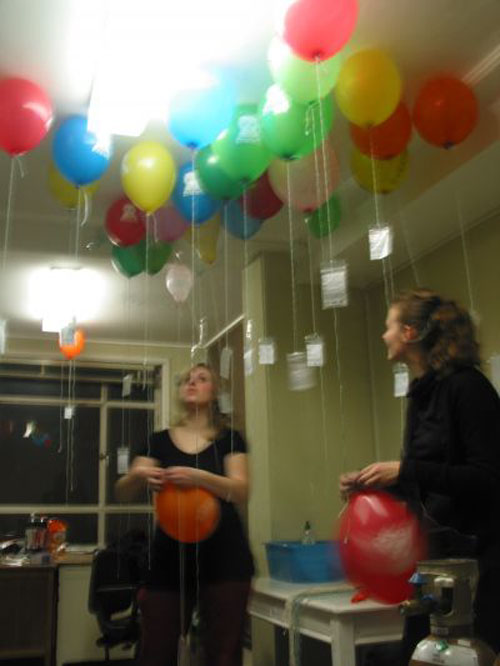
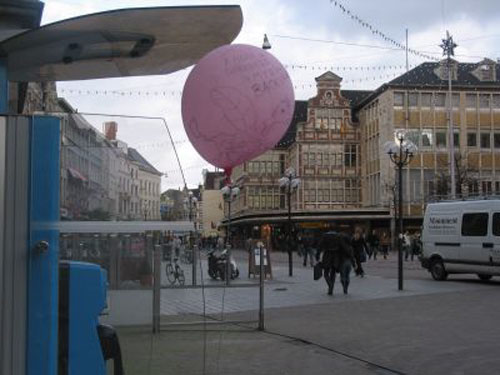
If you live in Ghent, Belgium you may have noticed that everywhere you went, tons of painted balloons suddenly appeared all over the city.
Using Myspace to launch a call for submission, a young girl collected over 400 balloons which people from all over the world drew on. She filled them with helium and put them up in major areas of Ghent.
You can see more here.
Posted by marc at 7:09 AM in Environmental |
February 24, 2007
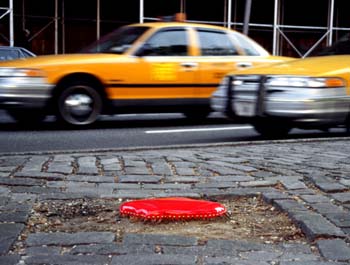
"The STUMP project began in 1999 on the sidewalks of New York City — the sidewalk plots where there are tree stumps are generally neglected spaces left to collect debris. The tree stumps reminded me of the childhood story, The Giving Tree by Shell Silverstein, in which a tree has given of herself to the point of being diminished to a stump, but selflessly perks herself up to give to the last, by providing a seat for the beloved boy who is now an aged man. To upholster the sidewalk stump was a way to honor that which had been diminished, and bring it back into relationship with the neighborhood."... artist Madelon Galland.
(via here, which found it here, which found it here)
Posted by marc at 7:54 AM in Environmental |
February 13, 2007
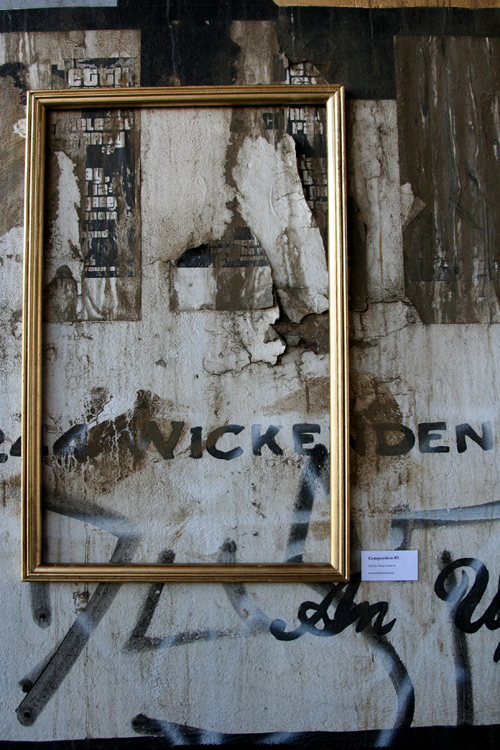
From UrbanCurators.com:
Mission Statement
"The goal of the Urban Curators project is to engage the public in the celebration of the decaying urban environment, recog- nizing its inherent aesthetic qualities as well as the important role that it plays within our cultural habitat. The project achieves its goal by elevating common, overlooked objects and spaces within the city of Providence, Rhode Island to the level of high art.
The project achieves this elevation by literally hanging gold, gallery-style frames in derelict spaces within the city, framing objects and views that are of aesthetic or cultural value. By utilizing frames that one might expect to find in an art museum or gallery, viewers are forced to make connections between the urban landscape and the museum environment. Viewers are likewise encouraged to reconsider their prior conceptions of beauty and worth, understanding that the spontaneity of decay offers an alternative aesthetic to excessive design.
Humans have for centuries sought after the grandeur of ruins that were once the glory of ancient cultures, recognizing them as windows into the lives of past civilizations. The Urban Curators project proposes that we should likewise cherish those ruins that reflect modern-day consumerism and industr- ialization, realizing them as vehicles by which we can gain insight into our own society.
The frames themselves are hung with double-sided hardware tape and are easily removed without harm to the spaces in which they are placed. While this is a necessary component of the project, it likewise means that each frame will hang only temporarily. Due to the transient nature of the project, its success requires time and effort from not only the Urban Curators team, but from the community as a whole. While the project was originally born by six Rhode Island School of Design students, it cannot continue without input and partic- ipation from others. We hope that the community will interact with the project – finding our frames, removing them, relocating them, and installing their own."
Posted by marc at 8:30 PM in Environmental |
February 3, 2007
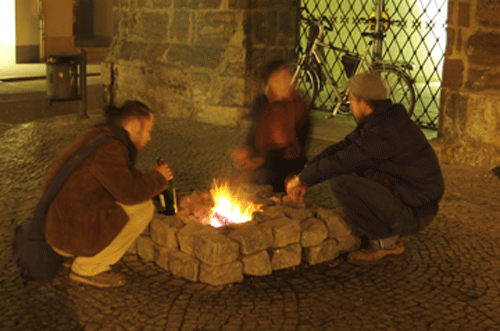
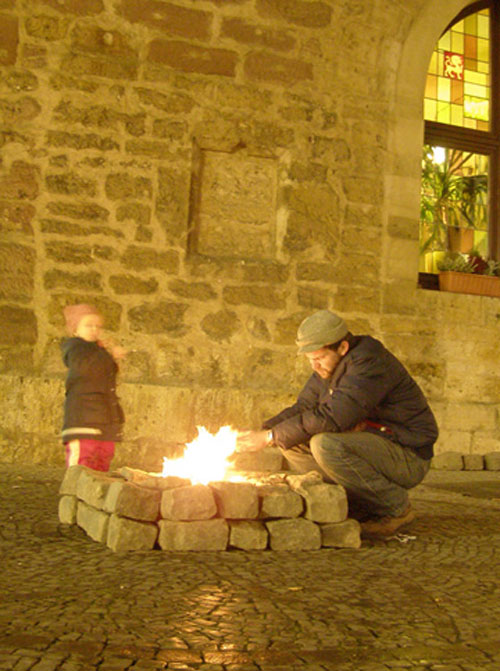
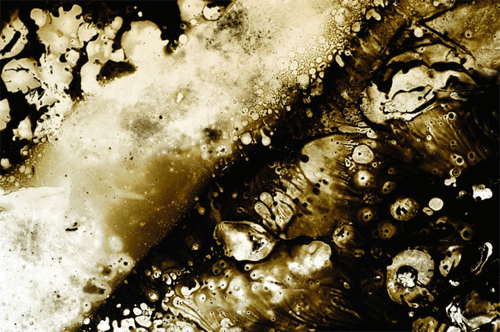
In Jena, Germany, the artist Steven Brown brought the power of the camp fire back into the urban environment.
In front of the town's City Hall on the main square, Steven built a stone hearth each night for 10 days (Jan 14-23 2007). He simply built and burned a fire from sunset until midnight. Each night people stopped by and lingered and shared stories. There was no press and word spread the old-fashioned way. Slowly, there became a regular base of people who came every night to interact (and often bring the artist food and drink).
Here's his artist statement:
Gather Change Gather
Steven Matthew Brown
Markt, Jena
14.01.2007 - 23.01.2007
On January 14, 2007, a small open cobblestone hearth appeared on the central Market of Jena. Small fires were built and tended from dusk until midnight for 10 consecutive nights. People periodically stopped to inquire about the fire, often staying for a while to talk or share stories. Under each day’s fire, pieces of fireproof glass captured a permanent record of the burning, a pyrograph in soot and carbon. At the end of each day’s burning the hearth was disassembled and the glass stored. A book containing carbon paper was used as a journal to collect a two-layer written impression of events. Once filled, one set of carbon copies was torn from the book and rebound in another smaller book.
Around the fire I met people I would likely not have otherwise met. As in life, strangers slowly became friends. Some returned every night, and some brought companions. Each person activated and helped define the experience, creating moments as dynamic and fleeting as the fire. One night a large family with children and parents and grandparents arrived. They had heard of the fire and bought sparklers specifically to light there in the cold. Suddenly and inexplicably I found myself in a swirling group of laughing children, their smiling faces alight with joy, the dappled warmth of the sparklers they held, and the slow glow of the fire. All that we have of our shared evenings now are memories, stains and residues like the marks on the glass and in the book. By generating this gathering place, by remaining open and patient I stumbled across something deeply human, something alive and impermanent, something perhaps one cannot seek to find.
Posted by marc at 3:32 AM in Environmental |
January 24, 2007
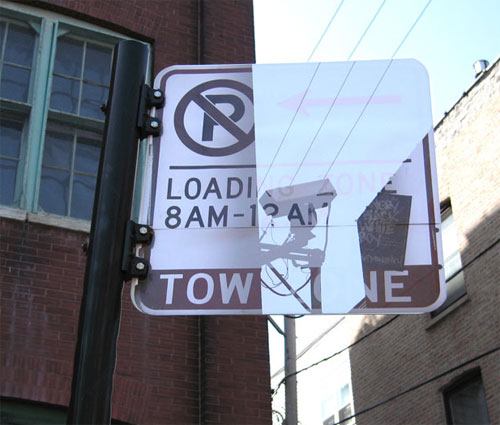
For the last three years, Cayetano Ferrer (aka Tano) has been installing a series of absolutely fascinating street sign in the city of Chicago. If you haven't yet seen them, here's a link to the entire series. After you look at the individual images, check out the video below...
It was no surprise to us that Tano's work is connected to the ideas and work of Gordon Matta-Clark. Here's an email that we received from Tano this morning....
"I´m really into the latest direction you´ve been taking. That building in Argentina was amazing, and that Fekner video was the best youtube video I've seen in ages... but especially seeing Krzysztof Wodiczko projections got me hyped. I too have been semi obsessed with projecting outdoors for a couple of years, and was turned onto his work by a professor around the time he was in the Interventionists show at Mass Moca. He was building these makeshift road-warrior style shopping carts and giving them to homeless people.
One thing I wanted to add is that when I see these recent posts I see a thread that would be complimented well by a particular artist... Gordon Matta-Clark. In my opinion, when it comes to street art his shit is fucking untouchable... he was the ultimate. He did a lot of his work illegally which is mind blowing to think about considering he was altering the structures of huge buildings. His influence by the early 70´s graffiti is evident by his obsessive documentation of the train pieces, but I also wonder how much he himself influenced the culture. He was doing his building cuts from 70-76... some of those early writers MUST have known about what he was doing. Eventually he got chased out of the country after he got caught, and spent some time in Europe before he suddenly died of cancer in 1978. Read up, I think the more you learn about him the more you´ll be amazed.
I was reminded of him by seeing John Fekner´s stencil work, which was new to me and also amazing to see... the way the history of the structure and the documentation of its destruction were so important to the work is really rad."
Posted by marc at 6:21 AM in Environmental |
January 18, 2007
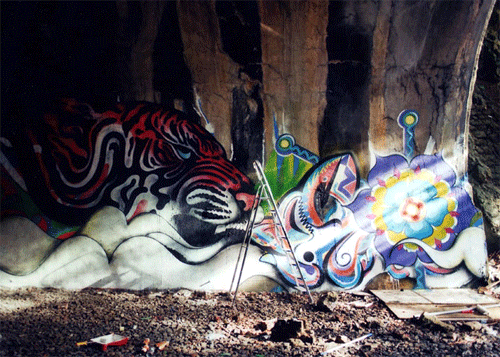
Natural Reaction by Kami & Sasu
In the weeks prior to the opening of the Wooster on Spring event, as the year was coming to a close, we spent a lot of time with the various artists over dinners and beers catching up on the different events and shows that they had been a part of during 2006.
The one event that everyone seemed to be talking about was "Outsides" that took place in Wuppertal, Germany back in August. We heard some great stories about it from JR and Mare139
For eight days over 22 artists from around the world painted in different locations around Wuppertal such that all of the pieces where completed and became known to the public all on the same day - August 18. Because of this, the entire city became an uncommissioned and guerrilla exhibition space with flyers giving local citizens the locations of each piece.
You can learn more about the project here.
Posted by marc at 6:40 AM in Environmental |
January 17, 2007
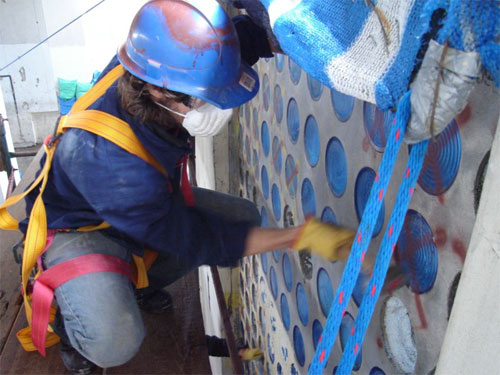
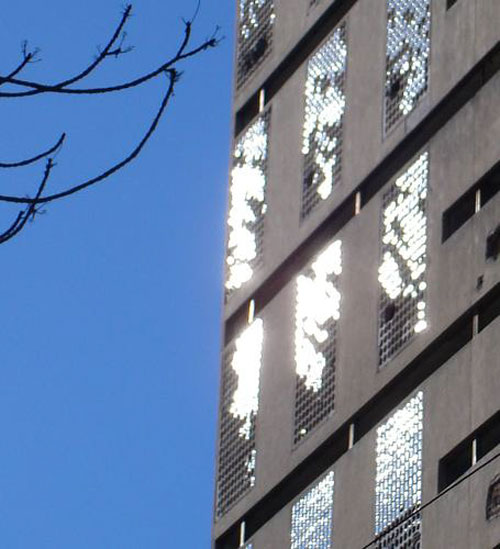
From Seth Wulsin:
The project uses the Caseros prison building in Buenos Aires and its demolition as raw materials. The point of entry for the work is the window grids that you can see in the photographs at this fotolog link.
These windows reflect the sun and moonlight from particular points on the streets below. Each window actually is a grid of 209 (11x19) circular blue windows, 8 inches (20 cm) in diameter which were originally designed to illuminate the recreation patios of the prison without allowing in direct sunlight. (the whole prison was designed so that inmates would have no direct contact with sunlight, a fact that was evident in the green skin of prisoners).
Each grid is about 18 feet tall and about 9 feet wide, corresponding to two floors of the prison. There are 48 grids in total that I worked with, 24 on the east side and 24 on the west side.
Breaking out certain windows, I created images of faces, where the light values are produced by the reflection of the sun in the windows that remain, and the dark values are given by the dark interior space of the prison, visible through the busted out windows. So the images are purely a function of two kinds of space -- tangible space, and optical reflective space, and the light and dark values present in those spaces, as well as the physical limits produced by the integral structure of the prison architecture itself.
These limits, and the conditions for the images themselves appearing, disappear according to the pace of the demolition.
The images are calibrated to the changes in light throughout the daily and yearly cycles, directed at specific points in the street below, formed and deformed according to where the sun appears in the sky at any given moment in relation to where the viewer stands.
The images are a point of encounter between the structure and materials of the prison building itself (including their destruction) the sun, moon and sky, and the various cycles of time they produce in the human experience based on the way they function in relation with the earth and vice versa, pedestrian movement in the street below, and of course, human consciousness and perception.
Really the project deals with the life cycle of a place, a building, a prison, a human creation, with all its architectural, idealogical, political, historical, psychological, spiritual (etc. etc) complexities and how its life cycle is affected and defined by its inhabitants, its neighbors, its inner and outer limits.
As a thought experiment, it could be possible to begin with a place, or an idea, or an event, and extrapolate out all the effects that it causes into the future and all the causes that affect it into the present, and thereby come up with some kind of complete picture of the universe, with the starting point -- whatever given place or idea -- as its center.
That's basically what I've been doing with this prison over the past year. It's at once a symbolic and very concrete manifestation of some of the worst aspects of modernism -- a kind of shadow exemplar for the 20th century -- fascist architecture, short-sighted technological arrogance, institutional repression, incompetant administration, sadistic quasi-justice, all these qualities and more converge on a building whose ultimate goal is both isolation and intimidation. The isolation is not just collective, cordoning off a dangerous population from the rest of society to diminish a threat to that society and carry out justice (the ostensible intent of most prisons in civilized societies), it is individual as the prison is designed to keep inmates as physically close, yet isolated from one another as possible. The prison's urban location underscores this feature, and allows for its intimidating architectural presence to cast its shadow on the surrounding neighborhood.
The prison quickly became the most tangible symbol of the military dictatorships that dominated argentine politics throughout the 40 years leading up to the bloodiest military junta spearheaded by Videla in 1976. It was precisely the prison building's looming visible presence in the landscape of Buenos Aires (it stands 30 blocks from Congreso, the seat of the national government, and the heart of the city, and is clearly visible from the main highway that passes through town that installed it in the argentine imagination as the physical representation of the repression they were being subjected to (albeit with the tacit support of many of its members). After the dictatorship fell, Caseros continued to operate, and remained a black eye for the democratic governments that have run the country since 1983 until the prison was shut down and condemned in 2001.
This project is only in its early stages. The prison was originally 22 stories tall in a neighborhood of 2-3 story houses, factories, and an unusual number of hospitals. On good days the pasta factory across the street fills the now gutted prison with the scent of fresh popcorn. The demolition, contracted out by the city government to the argentine military, is being carried out floor by floor, fom the top down using jackhammers, bobcats, and sledge hammers, in a slow process that adds an eery dimension to the death of this building. Like a 90 yr. old woman with veins full of piss and vinegar who is still somehow alive even though her organs stopped working years ago, this building (a mere toddler compared to the 90 yr. old woman) is disappearing only slowly, bit by bit, underscoring an architectural process -- destruction -- that is rarely paid much attention to as it is generally carried out in a few seconds by implosion, or over the course of decades by natural elements as a result of neglect. Like human death, destruction seems morbid, and to pay too much attention to it strikes us as somehow twisted. And yet destruction's essential nature to the life cycle of anything is so readily apparent to anyone who looks, that it is a wonder we don't pay it more attention beyond the preventative measures or tools of denial we use in order to try, at all costs to avoid staring death in the face.
Now 15 floors remain of the building, with about 36 of the original faces still shining and fading with the changes in light. The demolition is expected to take at least another year to complete, an estimate that is subject to the always delicate nature of city
politics
The faces, themselves a result of part of the demolition -- the breaking of windows -- activate the demolition of the whole building as it negates not just the positive physical structure of the building itself (with all its negative connotations), but the space,
itself a negation, of the images. As media is increasingly dominated by a digital format, and as the digital technology becomes more and more 'real' the basic logical question of how human consciousness creates continuity from discrete elements becomes all the more compelling. These images are stripped down to a very low number of components (pixels) that put them right at the edge of perceptibility. They rest on this edge on a number of levels -- in the use of only two values (light dark), and in the way they appear and disappear according to the sun changes. The images often evoke television stills, and in some sense, the whole work functions as a piece of real cinema, where the changes take place in real time across weeks and months -- and ultimately years, where the illumination comes from the sun, and where the continuity is produced by the viewer changing his or her physical position across space and through time. Suddenly, the building itself is a frame, framing a set of frames which constantly change through time, ultimately unframing themselves through the course of the demolition, until all that remains is a portion of sky, newly visible, and framed by the absence of a building that once cast its shadow on a whole neighborhood.
Posted by marc at 7:04 AM in Environmental |
January 11, 2007
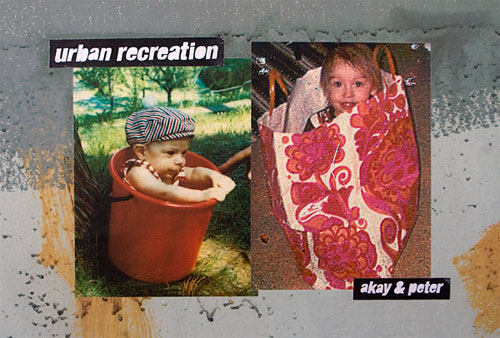
Behind every piece of art there's always a terrific story. The intrigue about street art is that most often it's impossible to know who the artist is, let alone know the story behind the work. One of the cool things for us is that we often learn the stories behind different pieces of work on the street, and we then share these stories with others through the Wooster site.
So when we first started to roam the streets of Soho many years ago, we would always walk past these two faded globes with the word "Akayism" on them. These posters lead us to learn more about the work of one of the true legends in street art today, Akay, who lives in Stockholm.
Akay's work is similar to that of artists like Dan Witz in that they think about their work in projects rather than random actions.
This month a terrific book called Urban Recreation is being published by Document. The book tells the stories behind the different projects of Akay and Peter, who together are known as the Barsky Brothers.
The work that these two guys do on the street is extremely rare, in the sense that it truly goes beyond spray cans and wheatpastes to be actual architectural structures and installations. The time, not to mention the money, that goes into their projects is remarkable. The book tells the stories behind thirteen projects done in the last four years.
Using material they find on the streets, Akay and Peter take ugly empty places and turn then into these magical little oases.
For us, Akay and Peter are the type of artists who have the ability to truly change the way people think about (a) their environment and (b) what should be in it and (c) what are definition of public art should be.
One of the projects that we really loved was City Swings in which for two weeks the Barsky Brothers installed 65 swings in Stockholm for people to enjoy, all made from found objects.
If there is one book that you should purchase this month, it's Urban Recreation. We've included photos of a few of the projects that the book showcases, but to get the stories behind them, buy the book. We're told that it willbe distributed in the US by From Here to Fame (NYC) and Last Gasp of San Francisco. We hear that both US distributors will probably have the book in stock in February or March.
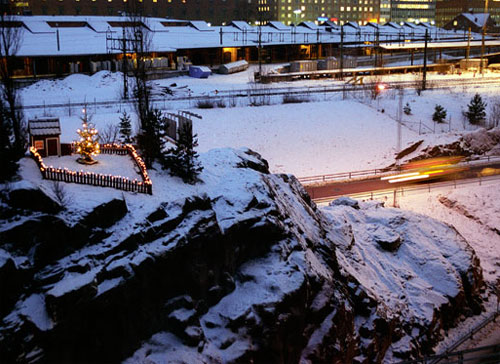
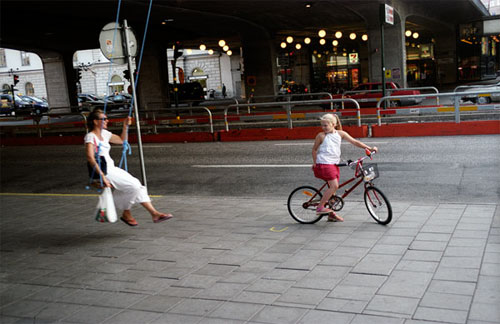
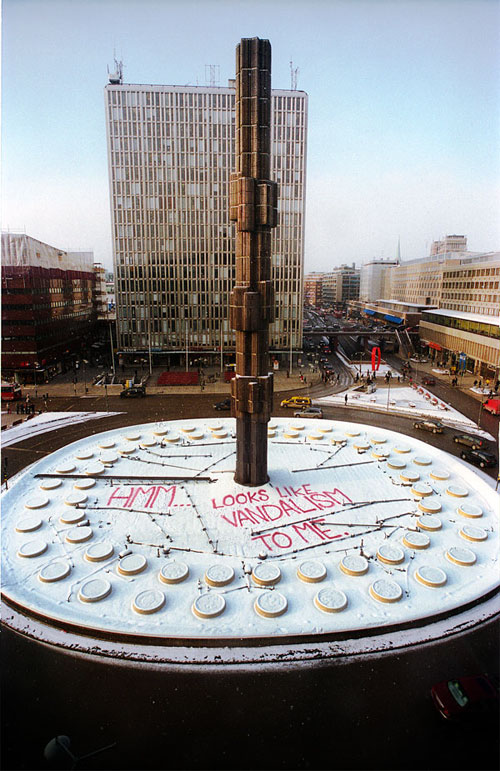
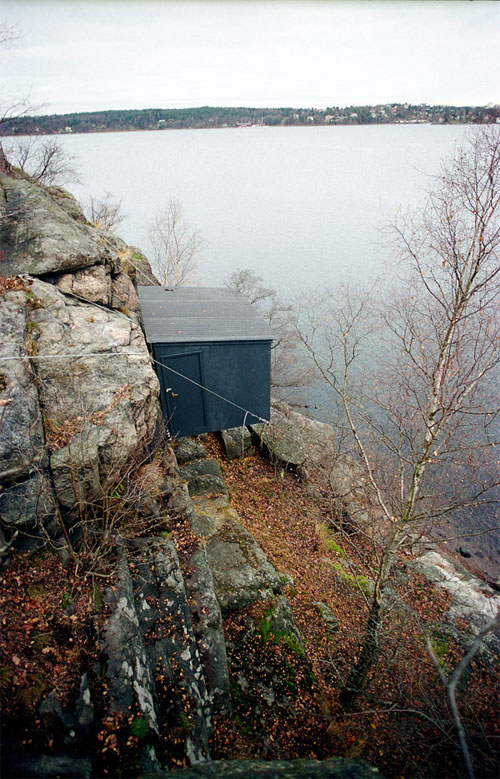
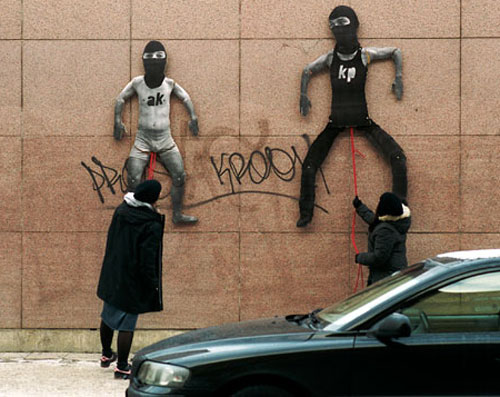
Posted by marc at 6:40 AM in Books , Culture Jamming , Environmental |
December 28, 2006
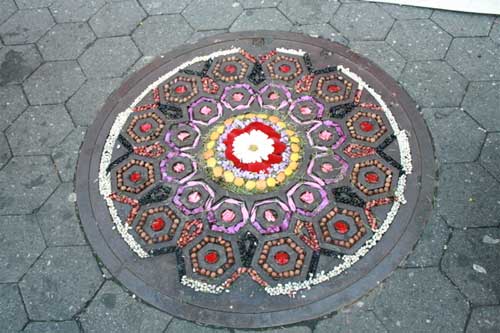
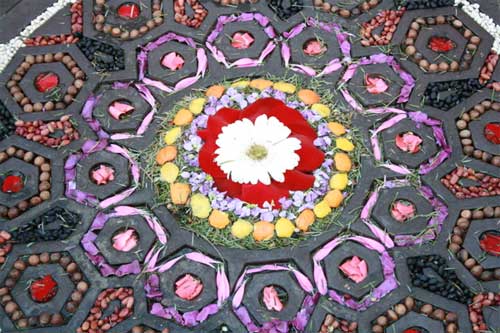
The other day we posted some photos of some lovely rose pedal artwork that we came across in our neighborhood of Soho. Yesterday Aileen sent us the photos above of a piece she stumbled this past Saturday in union square.
It goes without saying that we hope the artist continue to make them
Posted by marc at 10:11 PM in Environmental |
December 26, 2006
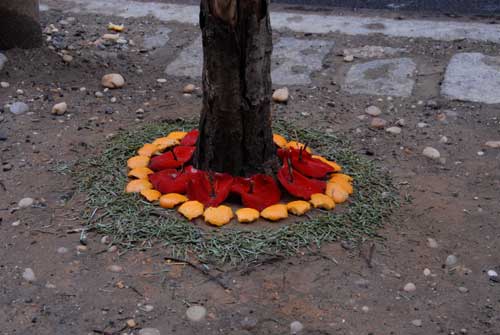
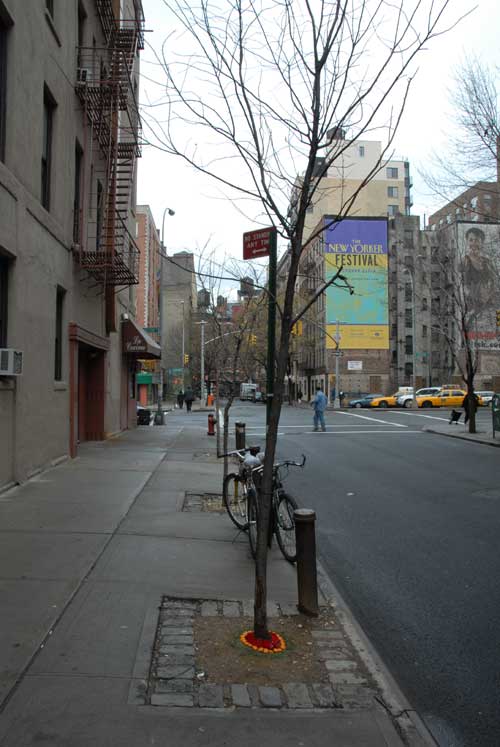
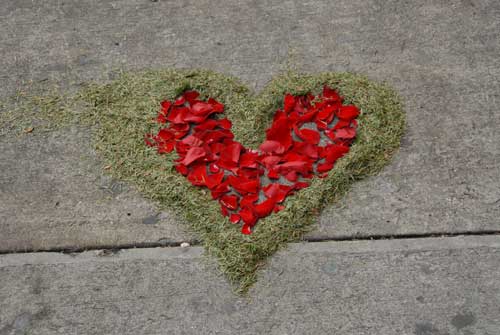
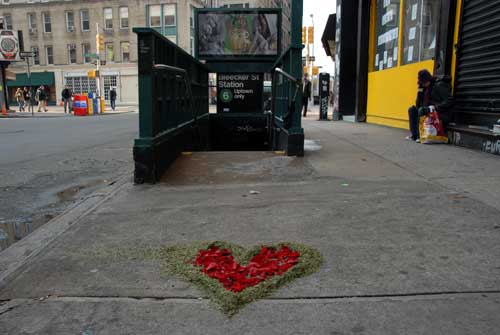
Found on our way to breakfast. Reminded us of the work of Andy Goldsworthy.
Artist unknown. At least to us.
Posted by marc at 3:47 PM in Environmental |






